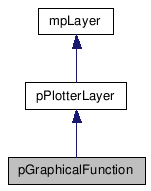
#include <pGraphicalFunction.h>

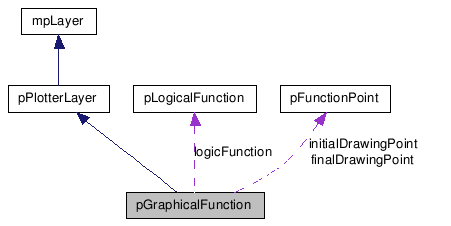
Public Member Functions | |
| pGraphicalFunction (wxString name=wxEmptyString, int flags=0x00) | |
| ~pGraphicalFunction () | |
| virtual int | getXTraslation () |
| virtual int | getmType () |
| virtual int | vGetType () |
| virtual void | getOffsets (int &offsetX, int &offSetY) |
| virtual void | getFactorZoom (float &fz) |
| virtual void | getFromWindowV (bool &fw) |
| virtual void | getIfActual (bool &actual) |
| virtual void | getMax (int &maxX, int &maxY) |
| virtual void | getMaxShowed (int &maxX, int &maxY) |
| virtual void | getMinShowed (int &minX, int &minY) |
| virtual void | getScreens (int &scrX, int &scrY) |
| virtual void | setScreens (int scrX, int scrY) |
| virtual void | getScales (double &scaleX, double &scaleY) |
| virtual void | getDrawing (bool &draw) |
| virtual void | ifShowPoints (bool &show) |
| virtual void | Rewind () |
| virtual bool | GetNextXY (double &x, double &y) |
| virtual void | GetPoints (wxList &points) |
| virtual void | getMousePoint (int &x, int &y) |
| virtual void | getSize (int &size) |
| virtual void | getDirection (bool &dir) |
| int | validPointOnFunction (wxPoint realPoint) |
| int | getIndexOf (wxPoint realpoint) |
| wxNode * | GetPointAt (int movingPointIndex) |
| bool | AddNewPoint (int x, int y) |
| bool | AddPoint (int aX, int aY, bool order=true) |
| bool | DeletePoint (int aX, int aY) |
| bool | changePoint (wxPoint newCoords, int movingIndexPoint) |
| double * | getX_RealValues () |
| double * | getY_RealValues () |
| bool | orderPoints () |
| bool | deletePointAt (int index) |
| int | getSizePoints () |
| void | setScales () |
| bool | isInFunction (int x, int y) |
| wxNode * | getBefore (pFunctionPoint *point) |
| bool | isInLine (pFunctionPoint *before, pFunctionPoint *next, pFunctionPoint *point) |
| double | interpolateY (double m, int x1, int y1, int x) |
| void | setUp () |
| void | clearSplineVectors () |
| void | initializeSplines () |
| void | addSplinesPoints () |
| void | initializeSplineVectors () |
| void | GetSplinePoint (double t, double &x, double &y) |
| virtual std::vector < double > | getXSpline () |
| virtual std::vector < double > | getYSpline () |
| virtual int | getOffsetPixelsXv () |
| virtual int | getOffsetPixelsYv () |
| void | save (wxString fileName) |
| void | load (wxString fileName) |
| void | SetShowPoints (bool showPoints) |
| bool | getShowPoints () |
| void | setScreenX (int scrX) |
| int | getScreenX () |
| void | setScreenY (int scrY) |
| int | getScreenY () |
| void | setStartX (double aStartX) |
| double | getStartX () |
| void | setStartY (double aStartY) |
| double | getStartY () |
| void | setEndX (double aEndX) |
| double | getEndX () |
| void | setEndY (double aEndY) |
| double | getEndY () |
| void | setScaleX (double aScaleX) |
| double | getScaleX () |
| void | setScaleY (double aScaleY) |
| double | getScaleY () |
| void | setMinX (double aMinX) |
| double | getMinX () |
| void | setMinY (double aMinY) |
| double | getMinY () |
| void | setMaxX (double aMaxX) |
| double | getMaxX () |
| void | setMaxY (double aMaxY) |
| double | getMaxY () |
| void | setOffsetX (double aOffsetX) |
| double | getOffsetX () |
| void | setOffsetY (double aOffsetY) |
| double | getOffsetY () |
| void | setType (int aType) |
| int | getType () |
| int | getValidPointRange () |
| void | setValidPointRange (int theRange) |
| void | SetDrawing (bool d) |
| bool | GetDrawing () |
| void | SetMousePoint (wxPoint p) |
| wxPoint | getMousePoint () |
| void | setActual (bool act) |
| bool | getActual () |
| void | setScaleWay (int typeS) |
| int | getScaleWay () |
| void | setFromWindow (bool w) |
| bool | getFromWindow () |
| void | setFactorZoom (float factor) |
| void | setEditable (bool edit) |
| bool | getEditable () |
| bool | getZoomB () |
| void | setZoomIn (bool z) |
| void | setInitialDrawPoint (pFunctionPoint *initialPoint) |
| pFunctionPoint * | getInitialDrawPoint () |
| void | setFinalDrawPoint (pFunctionPoint *finalPoint) |
| pFunctionPoint * | getFinallDrawPoint () |
| void | zooming (int clickedX, int clickedY, int width) |
| void | setOffsets (int offx, int offy) |
| void | setMinShowed () |
| int | getMinXShowed () |
| int | getMinYShowed () |
| int | getMaxXShowed () |
| int | getMaxYShowed () |
| void | setMinShowedX (int msx) |
| void | setMinShowedY (int msy) |
| void | setMaxShowedX (int msx) |
| void | setMaxShowedY (int msy) |
| int | getOffsetPixelsX () |
| int | getOffsetPixelsY () |
| void | setOffsetPixelX (int offX) |
| void | setOffsetPixelY (int offY) |
| void | setColorPoints (std::vector< pColorPoint * > &colorVector) |
| void | getColorPoints (std::vector< pColorPoint * > &colorVector) |
| void | setmType (int mt) |
| void | setXTraslation (int xT) |
| bool | initializePolygon (wxPoint *points, double x1, double y1, double x2, double y2) |
| void | draw (wxDC &dc, mpWindow &w, double x1, double y1, double x2, double y2, int orgy) |
| void | drawSplineCurve (wxDC &dc, mpWindow &w, int orgy) |
| void | drawLineToMousePoint (wxDC &dc, mpWindow &w, int orgy) |
| void | drawFunction (wxDC &dc, mpWindow &w, int orgy) |
| void | drawPoints (wxDC &dc, mpWindow &w, int orgy) |
| virtual void | Plot (wxDC &dc, mpWindow &w) |
| virtual bool | HasBBox () |
| virtual double | GetMinX () |
| virtual double | GetMaxX () |
| virtual double | GetMinY () |
| virtual double | GetMaxY () |
| wxString | GetName () const |
| const wxFont & | GetFont () const |
| const wxPen & | GetPen () const |
| void | SetName (wxString name) |
| void | SetFont (wxFont &font) |
| void | SetPen (wxPen &pen) |
| int | GetYTranslated (double sizey, double y) |
Protected Attributes | |
| int | m_flags |
| Holds label alignment. | |
| wxList | points |
| double | scaleX |
| double | scaleY |
| int | offsetX |
| int | offsetY |
| wxFont | m_font |
| Layer's font. | |
| wxPen | m_pen |
| Layer's pen. | |
| wxString | m_name |
| Layer's name. | |
Private Attributes | |
| pLogicalFunction * | logicFunction |
| bool | showPointsF |
| double | _startX |
| double | _startY |
| double | _endX |
| double | _endY |
| double | _scaleX |
| double | _scaleY |
| double | _minX |
| double | _minY |
| double | _maxX |
| double | _maxY |
| double | _offsetX |
| double | _offsetY |
| int | _type |
| wxList | realPoints |
| std::vector < pColorPoint * > | f_colorPoints |
| wxNode * | node |
| int | validPointRange |
| bool | drawing |
| wxPoint | mousePoint |
| int | screenX |
| int | screenY |
| bool | ifActual |
| int | scaleWay |
| bool | fromWindow |
| float | factorZoom |
| bool | editable |
| bool | zoomIn |
| pFunctionPoint * | initialDrawingPoint |
| pFunctionPoint * | finalDrawingPoint |
| int | minShowedX |
| int | maxShowedX |
| int | minShowedY |
| int | maxShowedY |
| std::vector< double > | xSpline |
| std::vector< double > | ySpline |
| vtkKochanekSpline * | xKSpline |
| vtkKochanekSpline * | yKSpline |
| int | offsetPixelX |
| int | offsetPixelY |
| int | mType |
| int | xTraslation |
Definition at line 68 of file pGraphicalFunction.h.
| pGraphicalFunction::pGraphicalFunction | ( | wxString | name = wxEmptyString, |
|
| int | flags = 0x00 | |||
| ) |
Definition at line 27 of file pGraphicalFunction.cxx.
References DEFAULT.
00028 { 00029 SetName(name); 00030 showPointsF = false; 00031 validPointRange = 5; 00032 logicFunction = new pLogicalFunction (); 00033 fromWindow=false; 00034 factorZoom=1; 00035 drawing=false; 00036 editable=true; 00037 ifActual=false; 00038 zoomIn=false; 00039 setOffsetX(0); 00040 setOffsetY(0); 00041 initialDrawingPoint=NULL; 00042 finalDrawingPoint=NULL; 00043 //type=1 means that is going to be a piecewise function 00044 _type=1; 00045 xKSpline=NULL; 00046 yKSpline=NULL; 00047 offsetPixelX=0; 00048 offsetPixelY=0; 00049 xTraslation=0; 00050 mType=DEFAULT; 00051 }
| pGraphicalFunction::~pGraphicalFunction | ( | ) |
| virtual int pGraphicalFunction::getXTraslation | ( | ) | [inline, virtual] |
Get the value of the traslation in the x-axis
Reimplemented from pPlotterLayer.
Definition at line 85 of file pGraphicalFunction.h.
References xTraslation.
00086 { 00087 return xTraslation; 00088 }
| virtual int pGraphicalFunction::getmType | ( | ) | [inline, virtual] |
Get the type of the curve 1=normal function 2=Histogram
Reimplemented from pPlotterLayer.
Definition at line 98 of file pGraphicalFunction.h.
References mType.
00099 { 00100 return mType; 00101 }
| virtual int pGraphicalFunction::vGetType | ( | ) | [inline, virtual] |
Get the type of the curve 1=piecewise functio 2= smooth
Reimplemented from pPlotterLayer.
Definition at line 108 of file pGraphicalFunction.h.
References _type.
00109 { 00110 return _type; 00111 }
| virtual void pGraphicalFunction::getOffsets | ( | int & | offsetX, | |
| int & | offSetY | |||
| ) | [inline, virtual] |
Get _offsetX and _offsetY
Reimplemented from pPlotterLayer.
Definition at line 117 of file pGraphicalFunction.h.
References _offsetX, _offsetY, and pPlotterLayer::offsetY.
| virtual void pGraphicalFunction::getFactorZoom | ( | float & | fz | ) | [inline, virtual] |
Reimplemented from pPlotterLayer.
Definition at line 126 of file pGraphicalFunction.h.
References factorZoom.
00127 { 00128 fz=factorZoom; 00129 }
| virtual void pGraphicalFunction::getFromWindowV | ( | bool & | fw | ) | [inline, virtual] |
Definition at line 135 of file pGraphicalFunction.h.
References fromWindow.
00136 { 00137 fw=fromWindow; 00138 }
| virtual void pGraphicalFunction::getIfActual | ( | bool & | actual | ) | [inline, virtual] |
if the function that is drawing is the actual
Reimplemented from pPlotterLayer.
Definition at line 144 of file pGraphicalFunction.h.
References ifActual.
00145 { 00146 actual=ifActual; 00147 }
| virtual void pGraphicalFunction::getMax | ( | int & | maxX, | |
| int & | maxY | |||
| ) | [inline, virtual] |
get the max of the function in x and y
Reimplemented from pPlotterLayer.
Definition at line 152 of file pGraphicalFunction.h.
References getMaxX(), and getMaxY().

| virtual void pGraphicalFunction::getMaxShowed | ( | int & | maxX, | |
| int & | maxY | |||
| ) | [inline, virtual] |
get the maxShowed of the function in x and y
Reimplemented from pPlotterLayer.
Definition at line 160 of file pGraphicalFunction.h.
References getMaxXShowed(), and getMaxYShowed().
00161 { 00162 maxX=(int)getMaxXShowed(); 00163 maxY=(int)getMaxYShowed(); 00164 }

| virtual void pGraphicalFunction::getMinShowed | ( | int & | minX, | |
| int & | minY | |||
| ) | [inline, virtual] |
get the minShowed of the function in x and y
Reimplemented from pPlotterLayer.
Definition at line 168 of file pGraphicalFunction.h.
References getMinXShowed(), and getMinYShowed().
00169 { 00170 minX=(int)getMinXShowed(); 00171 minY=(int)getMinYShowed(); 00172 }

| virtual void pGraphicalFunction::getScreens | ( | int & | scrX, | |
| int & | scrY | |||
| ) | [inline, virtual] |
Get screens of the function
Reimplemented from pPlotterLayer.
Definition at line 177 of file pGraphicalFunction.h.
References screenX, and screenY.
| virtual void pGraphicalFunction::setScreens | ( | int | scrX, | |
| int | scrY | |||
| ) | [inline, virtual] |
Set screens value
Reimplemented from pPlotterLayer.
Definition at line 186 of file pGraphicalFunction.h.
References screenX, and screenY.
Referenced by HistogramWidget::OnSize(), and pPlotterWindow::setActualScales().

| virtual void pGraphicalFunction::getScales | ( | double & | scaleX, | |
| double & | scaleY | |||
| ) | [inline, virtual] |
Let us know the scale of the function
Reimplemented from pPlotterLayer.
Definition at line 195 of file pGraphicalFunction.h.
References _scaleX, and _scaleY.
| virtual void pGraphicalFunction::getDrawing | ( | bool & | draw | ) | [inline, virtual] |
Let us Know if the user has finished the drawing that starts before.
Reimplemented from pPlotterLayer.
Definition at line 207 of file pGraphicalFunction.h.
References drawing.
| virtual void pGraphicalFunction::ifShowPoints | ( | bool & | show | ) | [inline, virtual] |
Let us Know if the user want to see the points of the function of other color than the color of the lines
Reimplemented from pPlotterLayer.
Definition at line 216 of file pGraphicalFunction.h.
References showPointsF.
00217 { 00218 show = showPointsF; 00219 }
| virtual void pGraphicalFunction::Rewind | ( | ) | [inline, virtual] |
Rewind
Reimplemented from pPlotterLayer.
Definition at line 224 of file pGraphicalFunction.h.
References pLogicalFunction::GetPointAt(), logicFunction, and node.
00225 { 00226 00227 node = logicFunction->GetPointAt(0); 00228 00229 }

| virtual bool pGraphicalFunction::GetNextXY | ( | double & | x, | |
| double & | y | |||
| ) | [inline, virtual] |
Get locus value for next N. Override this function in your implementation.
| x | Returns X value | |
| y | Returns Y value |
Reimplemented from pPlotterLayer.
Definition at line 236 of file pGraphicalFunction.h.
References pFunctionPoint::getRealX(), pFunctionPoint::getRealY(), and node.
00237 { 00238 if(node) 00239 { 00240 pFunctionPoint* p=(pFunctionPoint*)node->GetData(); 00241 x=p->getRealX(); 00242 y=p->getRealY(); 00243 node=node->GetNext(); 00244 return true; 00245 } 00246 return false; 00247 }

| virtual void pGraphicalFunction::GetPoints | ( | wxList & | points | ) | [inline, virtual] |
Get Point list of the funcion
| return | points |
Reimplemented from pPlotterLayer.
Definition at line 252 of file pGraphicalFunction.h.
References pLogicalFunction::GetPoints(), and logicFunction.
00253 { 00254 logicFunction->GetPoints(points); 00255 //points = realPoints; 00256 }

| virtual void pGraphicalFunction::getMousePoint | ( | int & | x, | |
| int & | y | |||
| ) | [inline, virtual] |
Get the point where the user made a click
Reimplemented from pPlotterLayer.
Definition at line 263 of file pGraphicalFunction.h.
References mousePoint.
00264 { 00265 x=mousePoint.x; 00266 y=mousePoint.y; 00267 }
| virtual void pGraphicalFunction::getSize | ( | int & | size | ) | [inline, virtual] |
Get the number of points of the function
Reimplemented from pPlotterLayer.
Definition at line 272 of file pGraphicalFunction.h.
References getSizePoints().
00273 { 00274 size=getSizePoints(); 00275 }

| virtual void pGraphicalFunction::getDirection | ( | bool & | dir | ) | [inline, virtual] |
this method gets the direction of the drawing
Reimplemented from pPlotterLayer.
Definition at line 280 of file pGraphicalFunction.h.
References logicFunction.
00281 { 00282 logicFunction -> getDirection (dir); 00283 }
| int pGraphicalFunction::validPointOnFunction | ( | wxPoint | realPoint | ) |
Definition at line 92 of file pGraphicalFunction.cxx.
References logicFunction.
Referenced by pPlotterWindow::onAddPoint(), pPlotterWindow::onDeletePoint(), and pPlotterWindow::onMouseMove().
00093 { 00094 return (logicFunction -> validPointOnFunction (realPoint)); 00095 }

| int pGraphicalFunction::getIndexOf | ( | wxPoint | realpoint | ) |
Definition at line 99 of file pGraphicalFunction.cxx.
References logicFunction.
00100 { 00101 return logicFunction -> getIndexOf( realpoint ); 00102 }
| wxNode * pGraphicalFunction::GetPointAt | ( | int | movingPointIndex | ) |
Definition at line 109 of file pGraphicalFunction.cxx.
References logicFunction.
Referenced by HistogramWidget::getTransferenceFunctionPoint(), and pPlotterWindow::onMouseMove().
00110 { 00111 return logicFunction -> GetPointAt ( movingPointIndex ); 00112 }

| bool pGraphicalFunction::AddNewPoint | ( | int | x, | |
| int | y | |||
| ) |
Definition at line 140 of file pGraphicalFunction.cxx.
References fromWindow, logicFunction, pLogicalFunction::setEndPoints(), pLogicalFunction::setStartPoints(), and setUp().
Referenced by pPlotterWindow::onAddNewPoint(), and pPlotterWindow::onAddPoint().
00141 { 00142 bool added= logicFunction -> AddNewPoint ( x, y ); 00143 if(!fromWindow) 00144 setUp(); 00145 else 00146 { 00147 logicFunction->setEndPoints(); 00148 logicFunction->setStartPoints(); 00149 } 00150 return added; 00151 }
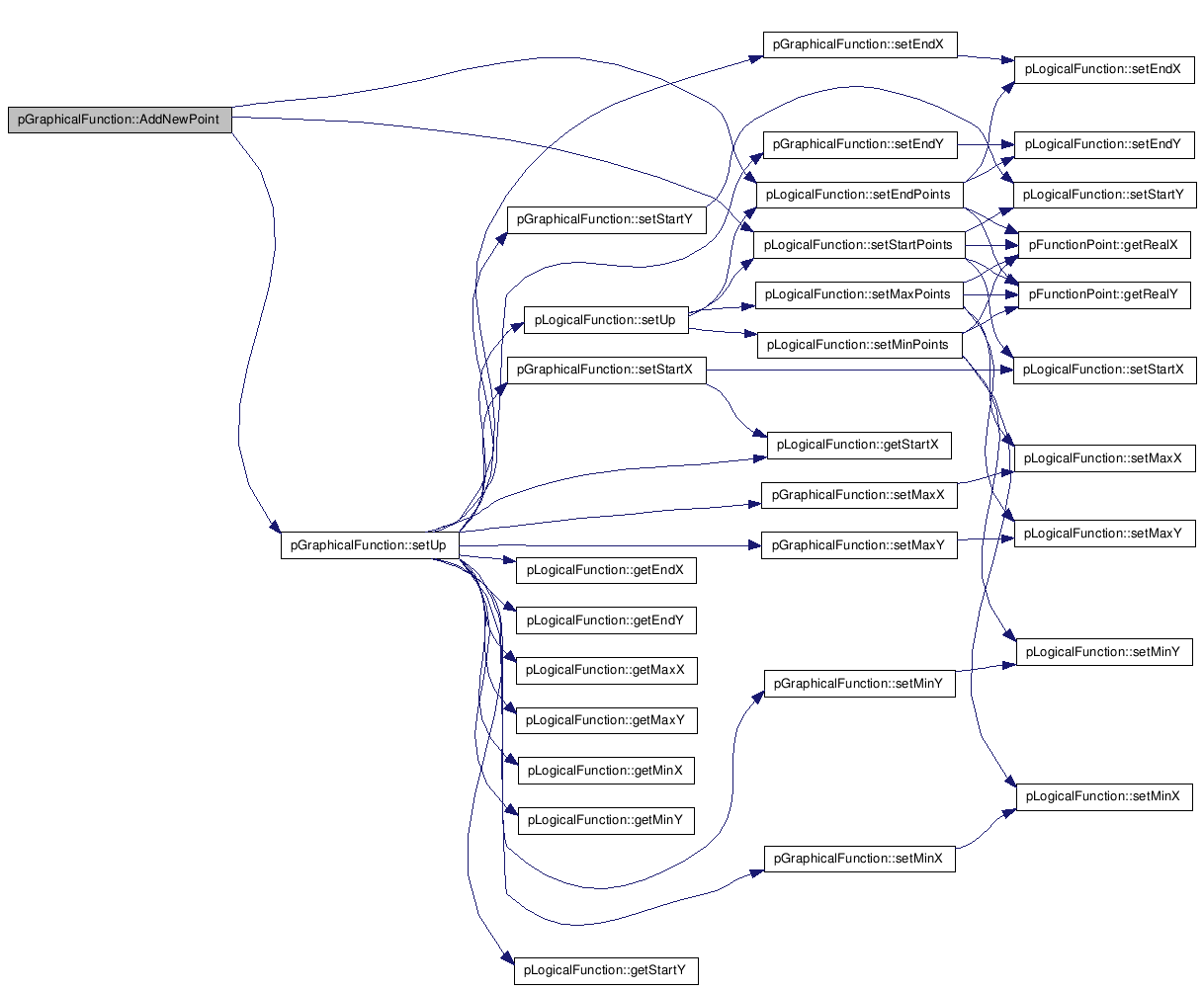

| bool pGraphicalFunction::AddPoint | ( | int | aX, | |
| int | aY, | |||
| bool | order = true | |||
| ) |
this method add a new logical point to the function, this point is one of those used to draw the function
Definition at line 160 of file pGraphicalFunction.cxx.
References fromWindow, logicFunction, pLogicalFunction::setEndPoints(), pLogicalFunction::setStartPoints(), and setUp().
Referenced by HistogramWidget::addPointToTransferenceFunction(), and pPlotterWindow::onAddPoint().
00161 { 00162 bool added=false; 00163 if (logicFunction!=NULL){ 00164 added=logicFunction -> AddPoint( aX, aY,order ); 00165 if(!fromWindow) 00166 setUp(); 00167 else 00168 { 00169 logicFunction->setEndPoints(); 00170 logicFunction->setStartPoints(); 00171 } // if fromWindow 00172 } // if logicFunction 00173 return added; 00174 }
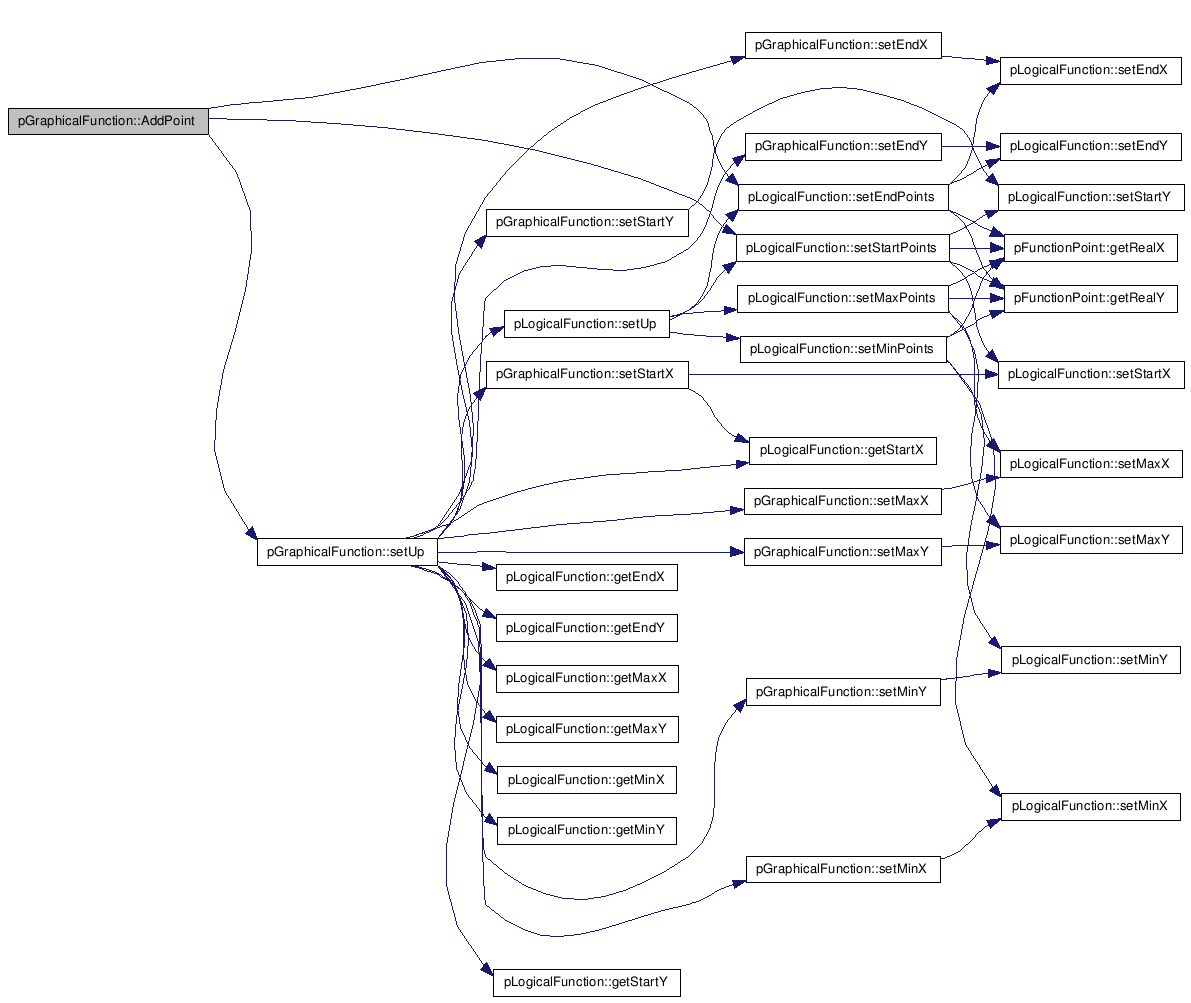

| bool pGraphicalFunction::DeletePoint | ( | int | aX, | |
| int | aY | |||
| ) |
deletes the point given by the user from the collection of logical points of the function
deletes the point given by the user from the collection of logical points of the function is not used
Definition at line 181 of file pGraphicalFunction.cxx.
References fromWindow, logicFunction, pLogicalFunction::setEndPoints(), pLogicalFunction::setStartPoints(), and setUp().
Referenced by pPlotterWindow::DeletePointFunction().
00182 { 00183 bool added= logicFunction -> DeletePoint( aX, aY ); 00184 if(!fromWindow) 00185 setUp(); 00186 else 00187 { 00188 logicFunction->setEndPoints(); 00189 logicFunction->setStartPoints(); 00190 } 00191 return added; 00192 }
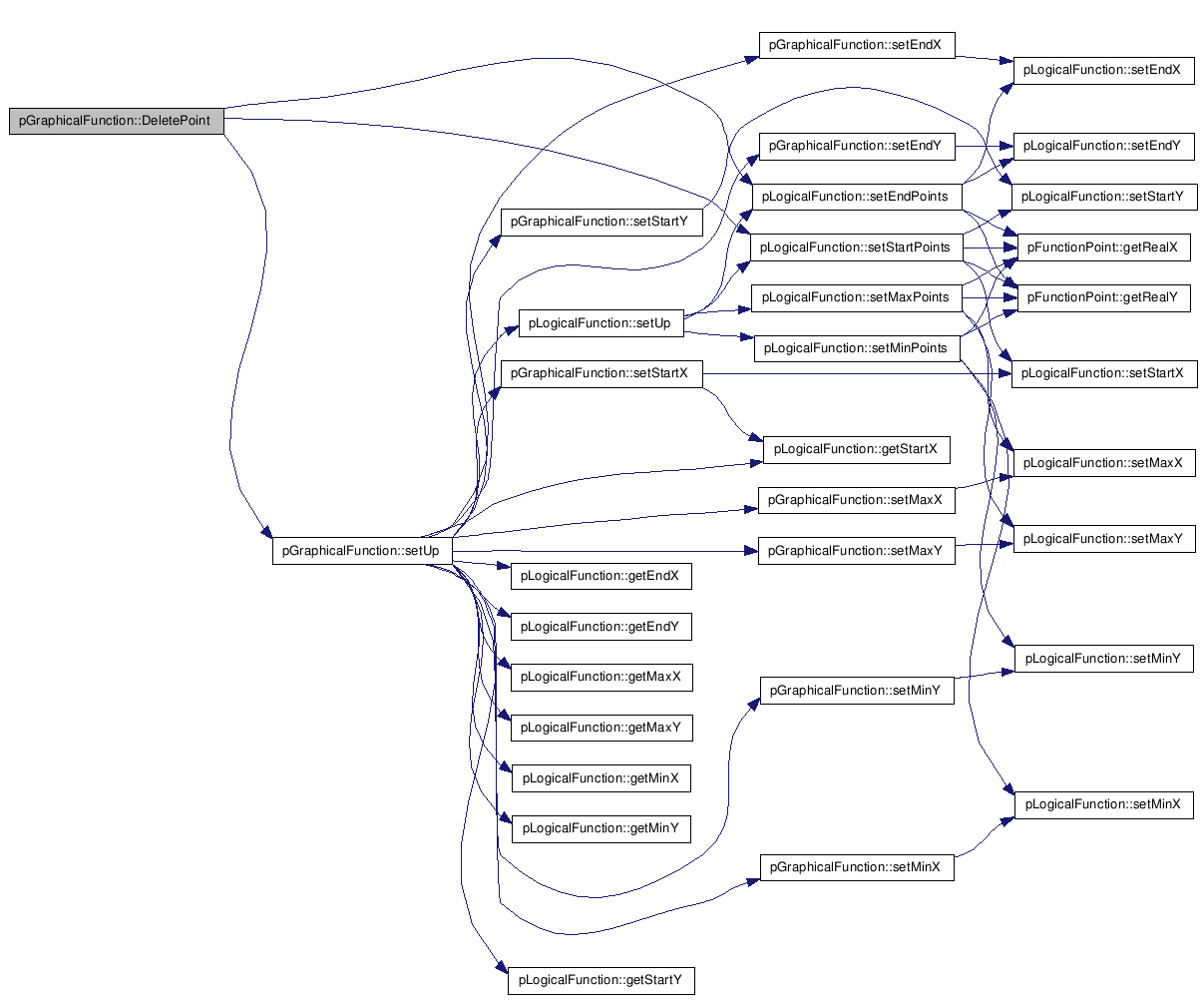

| bool pGraphicalFunction::changePoint | ( | wxPoint | newCoords, | |
| int | movingIndexPoint | |||
| ) |
Change de coordinates of the given point if it is possible and return the result of the invoked action. True if it was possible to do the change.
Change de coordinates of the given index point to the newCoords, if it is possible and return the result of the invoked action. Return TRUE if it was possible to do the change. A valid change is when the new x value of the point is still between the previous and next point, when condition.
Definition at line 214 of file pGraphicalFunction.cxx.
References fromWindow, logicFunction, pLogicalFunction::setEndPoints(), pLogicalFunction::setStartPoints(), and setUp().
Referenced by pPlotterWindow::onMouseMove().
00215 { 00216 bool added= (logicFunction -> changePoint( newCoords, movingIndexPoint )); 00217 if(!fromWindow) 00218 setUp(); 00219 else 00220 { 00221 logicFunction->setEndPoints(); 00222 logicFunction->setStartPoints(); 00223 } 00224 return added; 00225 }
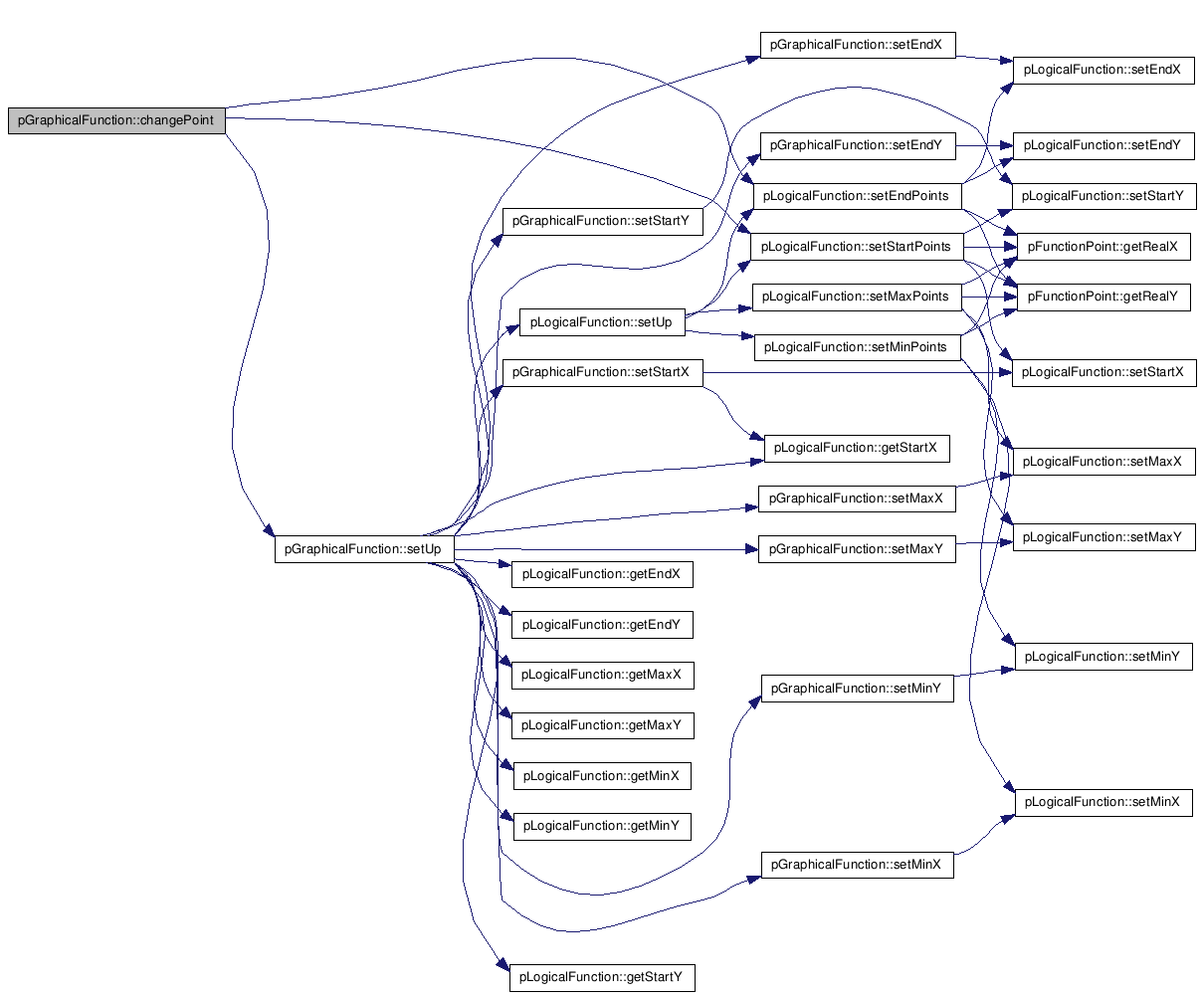

| double * pGraphicalFunction::getX_RealValues | ( | ) |
Evaluates if the given point belongs to the function. Returns the real x values of the control points of the function. It dont includes the points calculated by interpolation.
Definition at line 239 of file pGraphicalFunction.cxx.
References logicFunction.
Referenced by pPlotter::GetValuesPointsFunction().
00240 { 00241 return (logicFunction -> getX_RealValues( )); 00242 }

| double * pGraphicalFunction::getY_RealValues | ( | ) |
Returns the real y values of the control points of the function. It dont includes the points calculated by interpolation.
Definition at line 247 of file pGraphicalFunction.cxx.
References logicFunction.
Referenced by pPlotter::GetValuesPointsFunction().
00248 { 00249 00250 return (logicFunction -> getY_RealValues()); 00251 }

| bool pGraphicalFunction::orderPoints | ( | ) |
| bool pGraphicalFunction::deletePointAt | ( | int | index | ) |
This method get a pointer to the node in the real points list that is inmediately previous to the searched by parameter.
| realX | ||
| realY | Deletes a point of the function given its index |
Definition at line 197 of file pGraphicalFunction.cxx.
References fromWindow, logicFunction, pLogicalFunction::setEndPoints(), pLogicalFunction::setStartPoints(), and setUp().
Referenced by HistogramWidget::erasePointsTransferenceFunction(), and pPlotterWindow::onDeletePoint().
00198 { 00199 bool added=logicFunction -> deletePointAt( index ); 00200 if(!fromWindow) 00201 setUp(); 00202 else 00203 { 00204 logicFunction->setEndPoints(); 00205 logicFunction->setStartPoints(); 00206 } 00207 return added; 00208 }
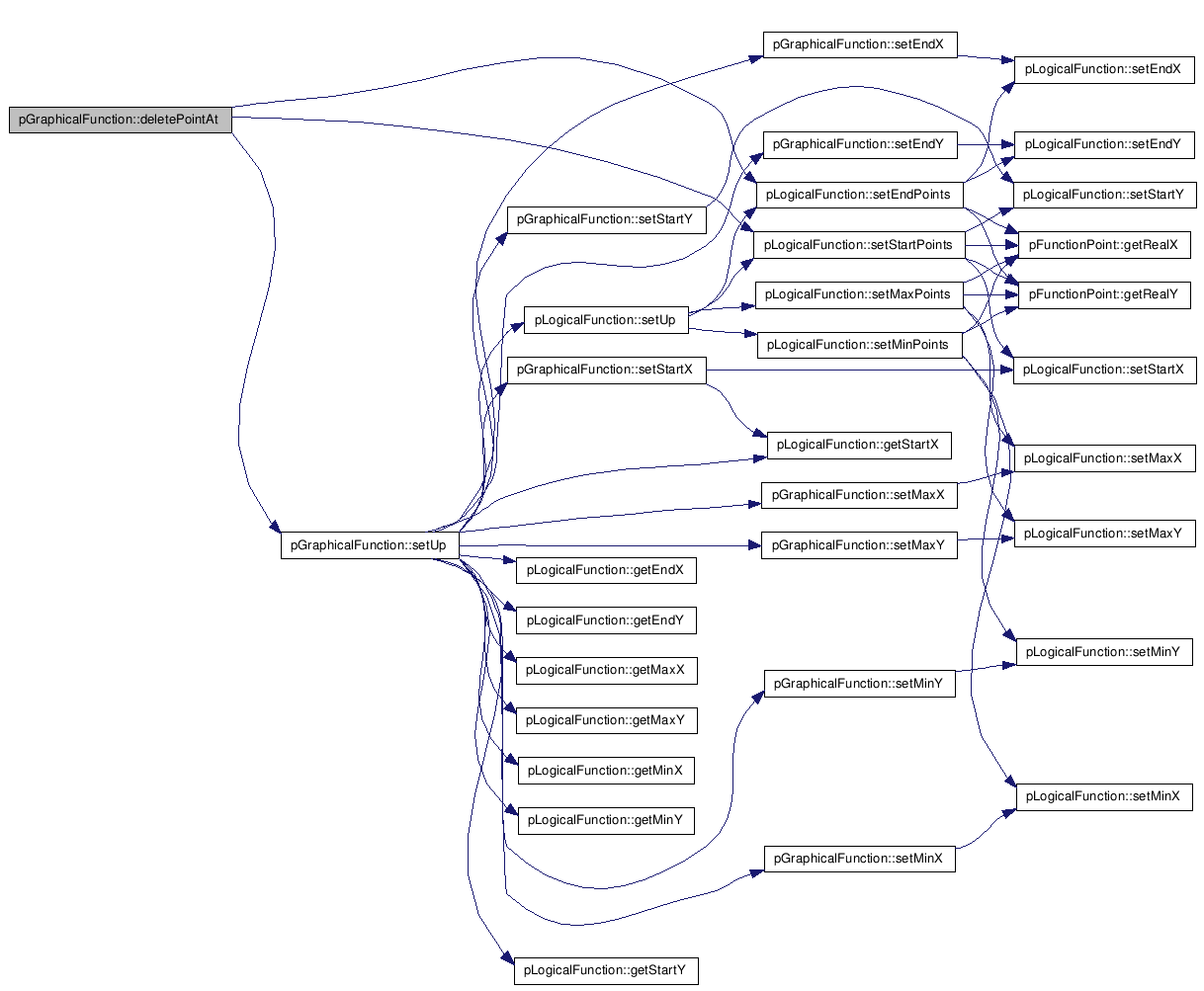

| int pGraphicalFunction::getSizePoints | ( | ) |
Definition at line 815 of file pGraphicalFunction.cxx.
References pLogicalFunction::getSizePoints(), and logicFunction.
Referenced by HistogramWidget::erasePointsTransferenceFunction(), getSize(), HistogramWidget::getSizeTransferenceFunction(), pPlotter::GetValuesPointsFunction(), pPlotterWindow::onDeletePoint(), pPlotterWindow::onMouseMove(), pPlotterWindow::onStopDrawing(), and zooming().
00816 { 00817 return logicFunction->getSizePoints(); 00818 }


| void pGraphicalFunction::setScales | ( | ) |
Definition at line 117 of file pGraphicalFunction.cxx.
References factorZoom, logicFunction, maxShowedX, maxShowedY, minShowedX, minShowedY, pPlotterLayer::scaleX, pPlotterLayer::scaleY, screenX, screenY, pLogicalFunction::setScaleX(), setScaleX(), pLogicalFunction::setScaleY(), and setScaleY().
Referenced by HistogramWidget::OnSize(), pPlotterWindow::setActualScales(), setOffsets(), and zooming().
00118 { 00119 //int dx= logicFunction->getMaxX()-logicFunction->getMinX(); 00120 //int dy= logicFunction->getMaxY()-logicFunction->getMinY(); 00121 int dx= maxShowedX-minShowedX; 00122 int dy= maxShowedY-minShowedY; 00123 00124 00125 if(dx!=0 && dy!=0) 00126 { 00127 double scaleX=(((float)(screenX-100))/dx)*factorZoom; 00128 double scaleY=(((float)(screenY-50))/dy)*factorZoom; 00129 setScaleX(scaleX); 00130 setScaleY(scaleY); 00131 logicFunction->setScaleX(scaleX); 00132 logicFunction->setScaleY(scaleY); 00133 00134 } 00135 }


| bool pGraphicalFunction::isInFunction | ( | int | x, | |
| int | y | |||
| ) |
Definition at line 261 of file pGraphicalFunction.cxx.
References getBefore(), and isInLine().
Referenced by pPlotterWindow::onChangeActual(), and pPlotterWindow::onMouseMove().
00262 { 00263 wxNode* before; 00264 wxNode* next; 00265 pFunctionPoint* point= new pFunctionPoint(x,y); 00266 bool inLine; 00267 before=getBefore(point); 00268 00269 if(before && before->GetNext()) 00270 { 00271 next = before->GetNext(); 00272 //next = (before->GetNext())->GetNext(); 00273 inLine= isInLine((pFunctionPoint*)before->GetData(),(pFunctionPoint*)next->GetData(),point); 00274 } 00275 else 00276 inLine=false; 00277 return inLine; 00278 }


| wxNode * pGraphicalFunction::getBefore | ( | pFunctionPoint * | point | ) |
Definition at line 283 of file pGraphicalFunction.cxx.
References pLogicalFunction::GetPointAt(), pFunctionPoint::getRealX(), logicFunction, and node.
Referenced by isInFunction().
00284 { 00285 int minDiference=10000000; 00286 wxNode* node=logicFunction->GetPointAt(0); 00287 wxNode* before=NULL; 00288 00289 while(node) 00290 { 00291 pFunctionPoint* before1=(pFunctionPoint*)node->GetData(); 00292 int beforeX=before1->getRealX(); 00293 int pointX=point->getRealX(); 00294 if(beforeX<pointX) 00295 { 00296 int minDiference1=pointX-beforeX; 00297 if(minDiference1<minDiference) 00298 { 00299 minDiference=minDiference1; 00300 before=node; 00301 } 00302 } 00303 node=node->GetNext(); 00304 } 00305 return before; 00306 }


| bool pGraphicalFunction::isInLine | ( | pFunctionPoint * | before, | |
| pFunctionPoint * | next, | |||
| pFunctionPoint * | point | |||
| ) |
Definition at line 310 of file pGraphicalFunction.cxx.
References pFunctionPoint::getRealX(), and pFunctionPoint::getRealY().
Referenced by isInFunction().
00311 { 00312 int x1,x2,x,y1,y2,y; 00313 00314 x1=(float)before->getRealX(); 00315 x2=(float)next->getRealX(); 00316 y1=(float)before->getRealY(); 00317 y2=(float)next->getRealY(); 00318 x=(float)point->getRealX(); 00319 y=(float)point->getRealY(); 00320 00321 00322 float d1= (float)sqrt(pow(float(x1-x),2)+ pow(float(y1-y),2)); 00323 float d2= (float)sqrt(pow(float(x2-x),2)+ pow(float(y2-y),2)); 00324 float d=(float)sqrt(pow(float(x2-x1),2)+ pow(float(y2-y1),2)); 00325 if(d1+d2<=(d*1.1) && d1<=d && d2<=d) 00326 return true; 00327 return false; 00328 }


| double pGraphicalFunction::interpolateY | ( | double | m, | |
| int | x1, | |||
| int | y1, | |||
| int | x | |||
| ) |
give us the value of y in the line define by the arguments
Definition at line 332 of file pGraphicalFunction.cxx.
| void pGraphicalFunction::setUp | ( | ) |
Definition at line 74 of file pGraphicalFunction.cxx.
References pLogicalFunction::getEndX(), pLogicalFunction::getEndY(), pLogicalFunction::getMaxX(), pLogicalFunction::getMaxY(), pLogicalFunction::getMinX(), pLogicalFunction::getMinY(), pLogicalFunction::getStartX(), pLogicalFunction::getStartY(), logicFunction, setEndX(), setEndY(), setMaxX(), setMaxY(), setMinX(), setMinY(), setStartX(), setStartY(), and pLogicalFunction::setUp().
Referenced by AddNewPoint(), AddPoint(), changePoint(), DeletePoint(), and deletePointAt().
00075 { 00076 logicFunction->setUp(); 00077 setMaxX(logicFunction->getMaxX()); 00078 setMinX(logicFunction->getMinX()); 00079 setMaxY(logicFunction->getMaxY()); 00080 setMinY(logicFunction->getMinY()); 00081 setStartX(logicFunction->getStartX()); 00082 setEndX(logicFunction->getEndX()); 00083 setStartY(logicFunction->getStartY()); 00084 setEndY(logicFunction->getEndY()); 00085 00086 }
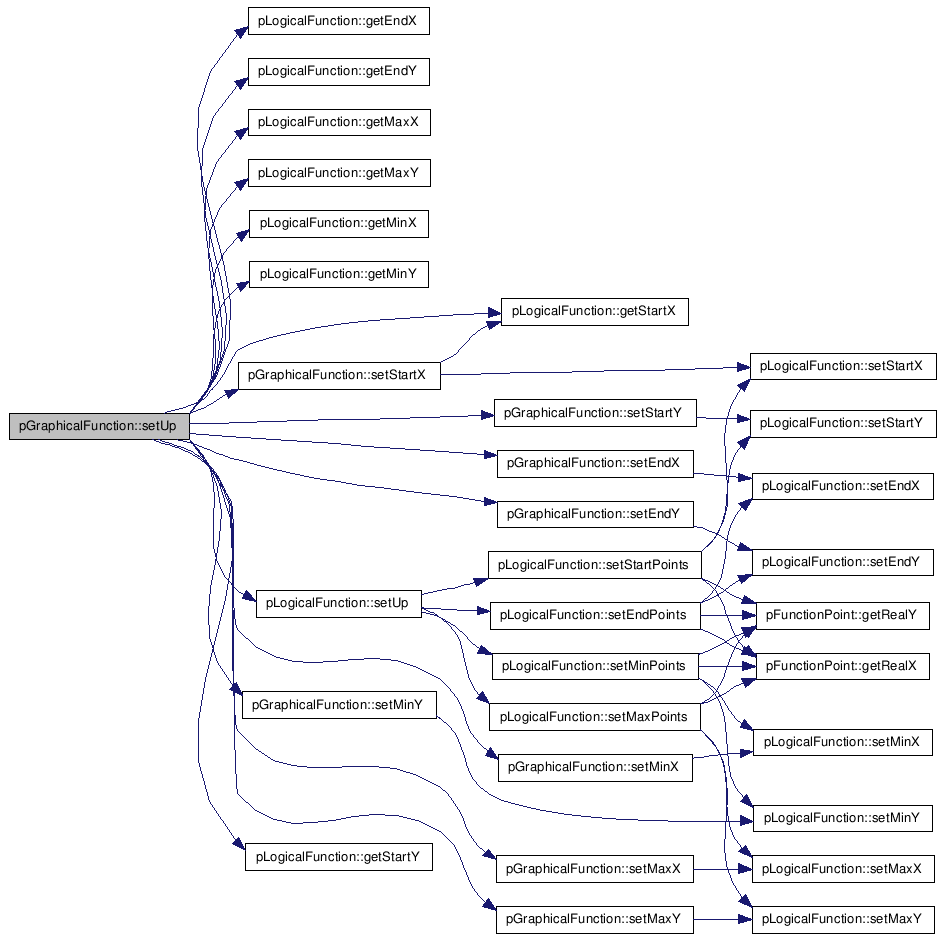

| void pGraphicalFunction::clearSplineVectors | ( | ) |
Definition at line 349 of file pGraphicalFunction.cxx.
References xSpline, and ySpline.
Referenced by pPlotterWindow::onAddNewPoint(), pPlotterWindow::onAddPoint(), pPlotterWindow::onChangeActual(), pPlotterWindow::onDeletePoint(), pPlotterWindow::onLine(), pPlotterWindow::onMouseMove(), and pPlotter::update().

| void pGraphicalFunction::initializeSplines | ( | ) |
Definition at line 358 of file pGraphicalFunction.cxx.
References addSplinesPoints(), xKSpline, and yKSpline.
Referenced by pPlotterWindow::addFunction(), and pPlotterWindow::onSplinePoints().
00359 { 00360 if(xKSpline==NULL) 00361 xKSpline = vtkKochanekSpline::New(); 00362 if(yKSpline==NULL) 00363 yKSpline= vtkKochanekSpline::New(); 00364 addSplinesPoints(); 00365 00366 }


| void pGraphicalFunction::addSplinesPoints | ( | ) |
Definition at line 372 of file pGraphicalFunction.cxx.
References pLogicalFunction::GetPointAt(), pFunctionPoint::getRealX(), pFunctionPoint::getRealY(), logicFunction, node, xKSpline, and yKSpline.
Referenced by initializeSplines(), pPlotterWindow::onAddNewPoint(), pPlotterWindow::onAddPoint(), pPlotterWindow::onChangeActual(), pPlotterWindow::onDeletePoint(), pPlotterWindow::onMouseMove(), and pPlotter::update().
00373 { 00374 xKSpline->RemoveAllPoints(); 00375 yKSpline->RemoveAllPoints(); 00376 wxNode *node= logicFunction->GetPointAt(0); 00377 pFunctionPoint* p; 00378 int i=0; 00379 while(node) 00380 { 00381 p=(pFunctionPoint*)node->GetData(); 00382 xKSpline->AddPoint(i,p->getRealX()); 00383 yKSpline->AddPoint(i,p->getRealY()); 00384 i++; 00385 node=node->GetNext(); 00386 } 00387 }


| void pGraphicalFunction::initializeSplineVectors | ( | ) |
Definition at line 392 of file pGraphicalFunction.cxx.
References pLogicalFunction::getSizePoints(), GetSplinePoint(), logicFunction, xSpline, and ySpline.
Referenced by pPlotterWindow::addFunction(), pPlotterWindow::onAddNewPoint(), pPlotterWindow::onAddPoint(), pPlotterWindow::onChangeActual(), pPlotterWindow::onDeletePoint(), pPlotterWindow::onMouseMove(), pPlotterWindow::onSplinePoints(), and pPlotter::update().
00393 { 00394 double x=0,y=0,t,delta; 00395 int i,np,nps; 00396 //realPoints.DeleteC 00397 00398 np = logicFunction->getSizePoints(); 00399 nps = 200; 00400 delta=( double ) ( np ) / ( double ) ( nps ); 00401 for( i = 0; i < nps; i++ ) 00402 { 00403 t = delta * (double)i; 00404 GetSplinePoint(t,x,y); 00405 xSpline.push_back(x); 00406 ySpline.push_back(y); 00407 } 00408 }


| void pGraphicalFunction::GetSplinePoint | ( | double | t, | |
| double & | x, | |||
| double & | y | |||
| ) |
Definition at line 412 of file pGraphicalFunction.cxx.
References pLogicalFunction::getSizePoints(), logicFunction, xKSpline, and yKSpline.
Referenced by initializeSplineVectors().
00413 { 00414 if (logicFunction->getSizePoints()==0) 00415 { 00416 x = 0; 00417 y = 0; 00418 } 00419 if (logicFunction->getSizePoints()>=2) 00420 { 00421 x = xKSpline->Evaluate(t); 00422 y = yKSpline->Evaluate(t); 00423 } 00424 }


| virtual std::vector<double> pGraphicalFunction::getXSpline | ( | ) | [inline, virtual] |
Reimplemented from pPlotterLayer.
Definition at line 426 of file pGraphicalFunction.h.
References xSpline.
00427 { 00428 return xSpline; 00429 }
| virtual std::vector<double> pGraphicalFunction::getYSpline | ( | ) | [inline, virtual] |
Reimplemented from pPlotterLayer.
Definition at line 433 of file pGraphicalFunction.h.
References ySpline.
00434 { 00435 return ySpline; 00436 }
| virtual int pGraphicalFunction::getOffsetPixelsXv | ( | ) | [inline, virtual] |
Gets the x-offset of the zoom in pixels
Reimplemented from pPlotterLayer.
Definition at line 443 of file pGraphicalFunction.h.
References offsetPixelX.
00444 { 00445 return offsetPixelX; 00446 }
| virtual int pGraphicalFunction::getOffsetPixelsYv | ( | ) | [inline, virtual] |
Gets the offset of the zoom in pixels
Reimplemented from pPlotterLayer.
Definition at line 452 of file pGraphicalFunction.h.
References offsetPixelY.
00453 { 00454 return offsetPixelY; 00455 }
| void pGraphicalFunction::save | ( | wxString | fileName | ) |
Definition at line 575 of file pGraphicalFunction.cxx.
References logicFunction, and pLogicalFunction::save().
Referenced by pPlotterWindow::onSave().
00576 { 00577 00578 logicFunction->save(fileName); 00579 00580 }


| void pGraphicalFunction::load | ( | wxString | fileName | ) |
Definition at line 584 of file pGraphicalFunction.cxx.
References pLogicalFunction::getMaxX(), pLogicalFunction::getMaxY(), pLogicalFunction::getMinX(), pLogicalFunction::getMinY(), pLogicalFunction::load(), logicFunction, setMaxShowedX(), setMaxShowedY(), setMinShowedX(), setMinShowedY(), and pLogicalFunction::setUp().
Referenced by pPlotterWindow::onLoad().
00585 { 00586 logicFunction->load(fileName); 00587 logicFunction->setUp(); 00588 setMaxShowedX(logicFunction->getMaxX()); 00589 setMinShowedX(logicFunction->getMinX()); 00590 setMaxShowedY(logicFunction->getMaxY()); 00591 setMinShowedY(logicFunction->getMinY()); 00592 }
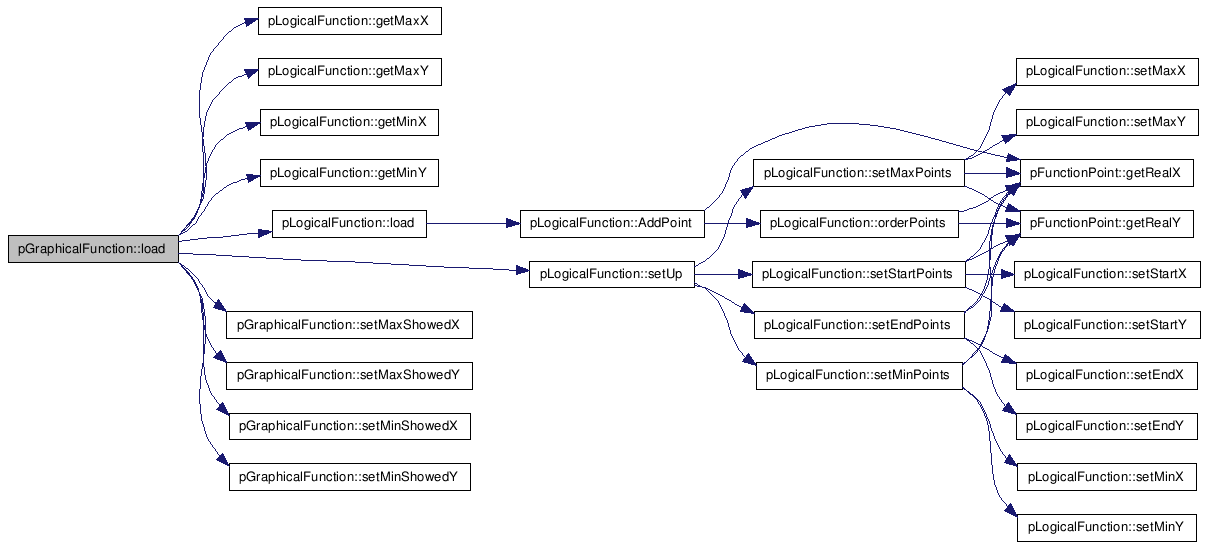

| void pGraphicalFunction::SetShowPoints | ( | bool | showPoints | ) |
Definition at line 62 of file pGraphicalFunction.cxx.
References showPointsF.
Referenced by HistogramWidget::drawTransferenceFunction(), pPlotterWindow::onNoShowPoints(), pPlotterWindow::onShowPoints(), and pPlotterWindow::onStartDrawing().
00063 { 00064 showPointsF = showPoints; 00065 }

| bool pGraphicalFunction::getShowPoints | ( | ) |
Definition at line 67 of file pGraphicalFunction.cxx.
References showPointsF.
Referenced by pPlotterWindow::onChangeActual(), and pPlotterWindow::onStartDrawing().
00068 { 00069 return showPointsF; 00070 }

| void pGraphicalFunction::setScreenX | ( | int | scrX | ) |
Definition at line 628 of file pGraphicalFunction.cxx.
References screenX.
Referenced by pPlotterWindow::onMouseMove(), pPlotterWindow::onMyZoomIn(), and pPlotterWindow::onMyZoomOut().
00629 { 00630 this->screenX=scrX; 00631 }

| int pGraphicalFunction::getScreenX | ( | ) |
Definition at line 632 of file pGraphicalFunction.cxx.
References screenX.
00633 { 00634 return this->screenX; 00635 }
| void pGraphicalFunction::setScreenY | ( | int | scrY | ) |
Definition at line 636 of file pGraphicalFunction.cxx.
References screenY.
Referenced by pPlotterWindow::onMouseMove(), pPlotterWindow::onMyZoomIn(), and pPlotterWindow::onMyZoomOut().
00637 { 00638 this->screenY=scrY; 00639 }

| int pGraphicalFunction::getScreenY | ( | ) |
Definition at line 640 of file pGraphicalFunction.cxx.
References screenY.
00641 { 00642 return this->screenY; 00643 }
| void pGraphicalFunction::setStartX | ( | double | aStartX | ) |
Definition at line 649 of file pGraphicalFunction.cxx.
References _startX, pLogicalFunction::getStartX(), logicFunction, and pLogicalFunction::setStartX().
Referenced by setUp().
00649 { 00650 00651 logicFunction->setStartX(aStartX); 00652 this->_startX =logicFunction->getStartX(); 00653 }


| double pGraphicalFunction::getStartX | ( | ) |
Definition at line 655 of file pGraphicalFunction.cxx.
References pLogicalFunction::getStartX(), and logicFunction.
00656 { 00657 return logicFunction->getStartX(); 00658 }

| void pGraphicalFunction::setStartY | ( | double | aStartY | ) |
Definition at line 660 of file pGraphicalFunction.cxx.
References _startY, logicFunction, and pLogicalFunction::setStartY().
Referenced by setUp().
00661 { 00662 logicFunction->setStartY(aStartY); 00663 this->_startY = aStartY; 00664 }


| double pGraphicalFunction::getStartY | ( | ) |
Definition at line 666 of file pGraphicalFunction.cxx.
References pLogicalFunction::getStartY(), and logicFunction.
00666 { 00667 return logicFunction->getStartY(); 00668 }

| void pGraphicalFunction::setEndX | ( | double | aEndX | ) |
Definition at line 672 of file pGraphicalFunction.cxx.
References _endX, logicFunction, and pLogicalFunction::setEndX().
Referenced by setUp().
00673 { 00674 logicFunction->setEndX(aEndX); 00675 this->_endX = aEndX; 00676 }


| double pGraphicalFunction::getEndX | ( | ) |
Definition at line 678 of file pGraphicalFunction.cxx.
References pLogicalFunction::getEndX(), and logicFunction.
00678 { 00679 return logicFunction->getEndX(); 00680 }

| void pGraphicalFunction::setEndY | ( | double | aEndY | ) |
Definition at line 682 of file pGraphicalFunction.cxx.
References _endY, logicFunction, and pLogicalFunction::setEndY().
Referenced by setUp().
00682 { 00683 logicFunction->setEndY(aEndY); 00684 this->_endY = aEndY; 00685 }


| double pGraphicalFunction::getEndY | ( | ) |
Definition at line 687 of file pGraphicalFunction.cxx.
References pLogicalFunction::getEndY(), and logicFunction.
00687 { 00688 return logicFunction->getEndY(); 00689 }

| void pGraphicalFunction::setScaleX | ( | double | aScaleX | ) |
Definition at line 693 of file pGraphicalFunction.cxx.
References _scaleX, logicFunction, and pLogicalFunction::setScaleX().
Referenced by setScales().
00694 { 00695 logicFunction->setScaleX(aScaleX); 00696 this->_scaleX = aScaleX; 00697 }


| double pGraphicalFunction::getScaleX | ( | ) |
Definition at line 699 of file pGraphicalFunction.cxx.
References _scaleX.
00700 { 00701 return this->_scaleX; 00702 }
| void pGraphicalFunction::setScaleY | ( | double | aScaleY | ) |
Definition at line 704 of file pGraphicalFunction.cxx.
References _scaleY, logicFunction, and pLogicalFunction::setScaleY().
Referenced by setScales().
00705 { 00706 logicFunction->setScaleY(aScaleY); 00707 this->_scaleY = aScaleY; 00708 }


| double pGraphicalFunction::getScaleY | ( | ) |
Definition at line 710 of file pGraphicalFunction.cxx.
References _scaleY.
Referenced by pPlotter::GetValuesPointsFunction().
00710 { 00711 return this->_scaleY; 00712 }

| void pGraphicalFunction::setMinX | ( | double | aMinX | ) |
Definition at line 716 of file pGraphicalFunction.cxx.
References _minX, logicFunction, and pLogicalFunction::setMinX().
Referenced by pPlotterWindow::onStartDrawing(), and setUp().
00717 { 00718 logicFunction->setMinX(aMinX); 00719 this->_minX = aMinX; 00720 }


| double pGraphicalFunction::getMinX | ( | ) |
Definition at line 722 of file pGraphicalFunction.cxx.
References pLogicalFunction::getMinX(), and logicFunction.
Referenced by HistogramWidget::getActualShowedPorcentage(), HistogramWidget::getMaxShowedPorcentage(), HistogramWidget::getMinShowedPorcentage(), pPlotterWindow::InitFunctionForVectors(), pPlotterWindow::moveFunctions(), pPlotter::onChangeFunction(), and pPlotter::setAll().
00723 { 00724 return logicFunction->getMinX(); 00725 }

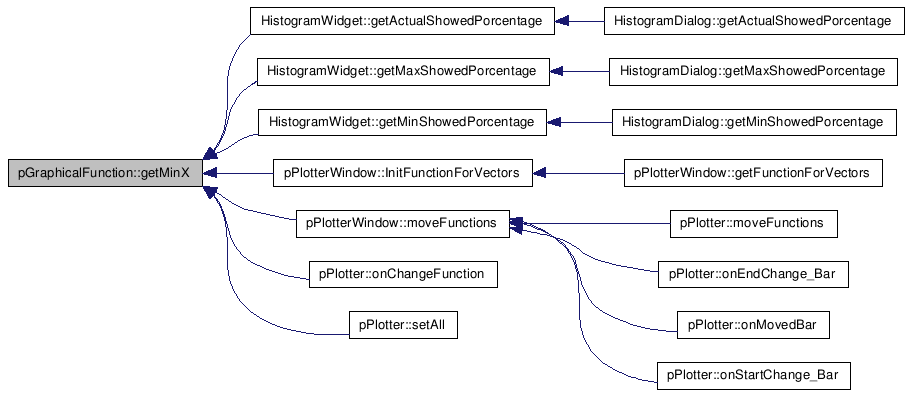
| void pGraphicalFunction::setMinY | ( | double | aMinY | ) |
Definition at line 727 of file pGraphicalFunction.cxx.
References _minY, logicFunction, and pLogicalFunction::setMinY().
Referenced by pPlotterWindow::onStartDrawing(), and setUp().
00728 { 00729 logicFunction->setMinY(aMinY); 00730 this->_minY = aMinY; 00731 }


| double pGraphicalFunction::getMinY | ( | ) |
Definition at line 733 of file pGraphicalFunction.cxx.
References pLogicalFunction::getMinY(), and logicFunction.
Referenced by pPlotterWindow::InitFunctionForVectors(), and pPlotterWindow::moveFunctions().
00733 { 00734 return logicFunction->getMinY(); 00735 }


| void pGraphicalFunction::setMaxX | ( | double | aMaxX | ) |
Definition at line 739 of file pGraphicalFunction.cxx.
References _maxX, logicFunction, and pLogicalFunction::setMaxX().
Referenced by pPlotterWindow::onStartDrawing(), and setUp().
00740 { 00741 logicFunction->setMaxX(aMaxX); 00742 this->_maxX = aMaxX; 00743 }


| double pGraphicalFunction::getMaxX | ( | ) |
Definition at line 745 of file pGraphicalFunction.cxx.
References pLogicalFunction::getMaxX(), and logicFunction.
Referenced by HistogramWidget::getActualShowedPorcentage(), getMax(), HistogramWidget::getMaxShowedPorcentage(), HistogramWidget::getMinShowedPorcentage(), pPlotterWindow::InitFunctionForVectors(), pPlotterWindow::moveFunctions(), pPlotter::onChangeFunction(), and pPlotter::setAll().
00746 { 00747 return logicFunction->getMaxX(); 00748 }

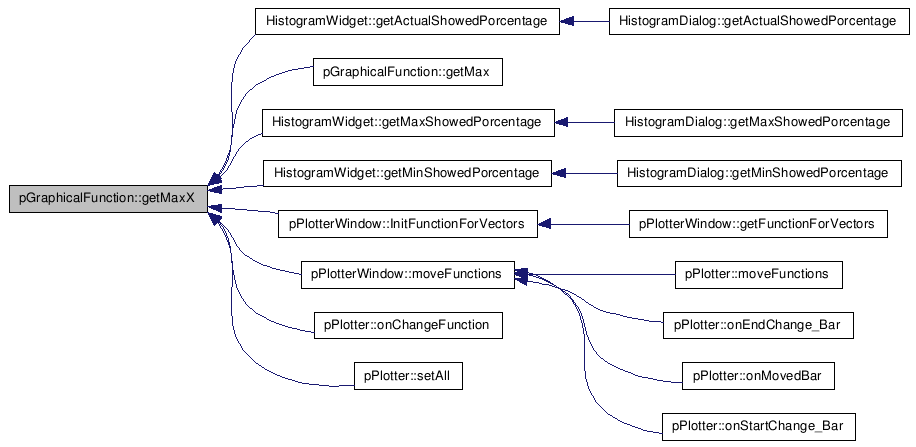
| void pGraphicalFunction::setMaxY | ( | double | aMaxY | ) |
Definition at line 750 of file pGraphicalFunction.cxx.
References _maxY, logicFunction, and pLogicalFunction::setMaxY().
Referenced by pPlotterWindow::onStartDrawing(), and setUp().
00751 { 00752 logicFunction->setMaxY(aMaxY); 00753 this->_maxY = aMaxY; 00754 }


| double pGraphicalFunction::getMaxY | ( | ) |
Definition at line 756 of file pGraphicalFunction.cxx.
References pLogicalFunction::getMaxY(), and logicFunction.
Referenced by getMax(), pPlotterWindow::InitFunctionForVectors(), and pPlotterWindow::moveFunctions().
00756 { 00757 return logicFunction->getMaxY(); 00758 }


| void pGraphicalFunction::setOffsetX | ( | double | aOffsetX | ) |
Definition at line 763 of file pGraphicalFunction.cxx.
References _offsetX, logicFunction, and pLogicalFunction::setOffsetX().
Referenced by pPlotterWindow::actualizeViewRange(), pPlotterWindow::moveFunctions(), pPlotterWindow::onMyZoomIn(), pPlotterWindow::onMyZoomOut(), and setOffsets().
00764 { 00765 logicFunction->setOffsetX(aOffsetX); 00766 this->_offsetX = aOffsetX; 00767 }


| double pGraphicalFunction::getOffsetX | ( | ) |
Definition at line 769 of file pGraphicalFunction.cxx.
References _offsetX.
Referenced by pPlotterWindow::onChangeActual(), pPlotterWindow::onMyZoomIn(), pPlotterWindow::onMyZoomOut(), and pPlotterWindow::onStartDrawing().
00770 { 00771 00772 return this->_offsetX; 00773 }
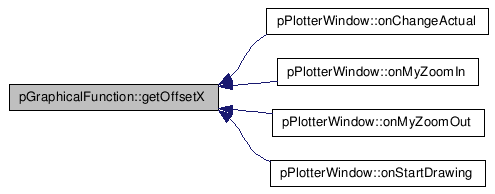
| void pGraphicalFunction::setOffsetY | ( | double | aOffsetY | ) |
Definition at line 775 of file pGraphicalFunction.cxx.
References _offsetY, logicFunction, and pLogicalFunction::setOffsetY().
Referenced by pPlotterWindow::onMyZoomIn(), pPlotterWindow::onMyZoomOut(), and setOffsets().
00776 { 00777 logicFunction->setOffsetY(aOffsetY); 00778 this->_offsetY = aOffsetY; 00779 }


| double pGraphicalFunction::getOffsetY | ( | ) |
Definition at line 781 of file pGraphicalFunction.cxx.
References _offsetY.
Referenced by pPlotterWindow::onChangeActual(), pPlotterWindow::onMyZoomIn(), pPlotterWindow::onMyZoomOut(), and pPlotterWindow::onStartDrawing().
00781 { 00782 return this->_offsetY; 00783 }
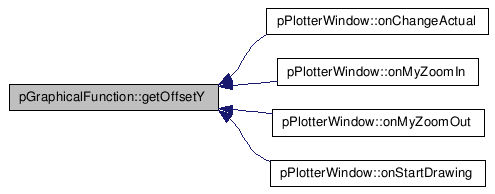
| void pGraphicalFunction::setType | ( | int | aType | ) |
Definition at line 788 of file pGraphicalFunction.cxx.
References _type, logicFunction, and pLogicalFunction::setType().
Referenced by HistogramWidget::drawHistogram(), Histogram::drawHistogram(), HistogramWidget::drawTransferenceFunction(), pPlotterWindow::onLine(), and pPlotterWindow::onSplinePoints().
00789 { 00790 logicFunction->setType(aType); 00791 this->_type = aType; 00792 }


| int pGraphicalFunction::getType | ( | ) |
Definition at line 794 of file pGraphicalFunction.cxx.
References _type.
Referenced by pPlotterWindow::addFunction(), pPlotterWindow::onAddNewPoint(), pPlotterWindow::onAddPoint(), pPlotterWindow::onChangeActual(), pPlotterWindow::onDeletePoint(), pPlotterWindow::onMouseMove(), and pPlotter::update().
00794 { 00795 return this->_type; 00796 }

| int pGraphicalFunction::getValidPointRange | ( | ) |
Definition at line 801 of file pGraphicalFunction.cxx.
References validPointRange.
00802 { 00803 return validPointRange; 00804 }
| void pGraphicalFunction::setValidPointRange | ( | int | theRange | ) |
Definition at line 806 of file pGraphicalFunction.cxx.
References logicFunction, pLogicalFunction::setValidPointRange(), and validPointRange.
00807 { 00808 logicFunction->setValidPointRange(theRange); 00809 validPointRange = theRange; 00810 }

| void pGraphicalFunction::SetDrawing | ( | bool | d | ) | [inline] |
Definition at line 544 of file pGraphicalFunction.h.
References drawing.
Referenced by pPlotterWindow::onLoad(), pPlotterWindow::onStartDrawing(), and pPlotterWindow::onStopDrawing().
00545 { 00546 drawing = d; 00547 }

| bool pGraphicalFunction::GetDrawing | ( | ) | [inline] |
Definition at line 549 of file pGraphicalFunction.h.
References drawing.
00550 { 00551 return drawing; 00552 }
| void pGraphicalFunction::SetMousePoint | ( | wxPoint | p | ) | [inline] |
Definition at line 555 of file pGraphicalFunction.h.
References mousePoint.
Referenced by pPlotterWindow::onMouseMove().
00556 { 00557 mousePoint = p; 00558 }

| wxPoint pGraphicalFunction::getMousePoint | ( | ) | [inline] |
Definition at line 560 of file pGraphicalFunction.h.
References mousePoint.
00561 { 00562 return mousePoint; 00563 }
| void pGraphicalFunction::setActual | ( | bool | act | ) |
actual
Definition at line 600 of file pGraphicalFunction.cxx.
References ifActual.
Referenced by HistogramWidget::drawTransferenceFunction(), pPlotterWindow::onLoad(), pPlotterWindow::onStartDrawing(), and pPlotterWindow::setActualFunction().
00601 { 00602 ifActual=act; 00603 }

| bool pGraphicalFunction::getActual | ( | ) |
Definition at line 604 of file pGraphicalFunction.cxx.
References ifActual.
Referenced by pPlotterWindow::moveFunctions(), pPlotterWindow::onChangeActual(), pPlotterWindow::onMyZoomIn(), and pPlotterWindow::onMyZoomOut().
00605 { 00606 return ifActual; 00607 }
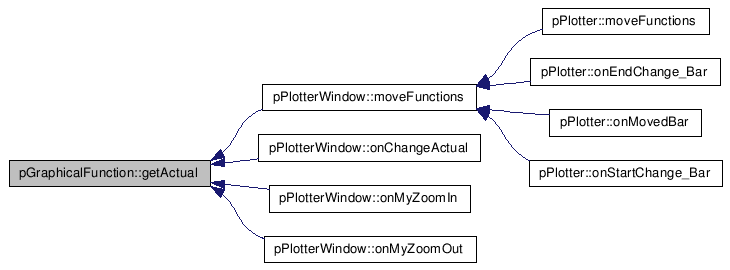
| void pGraphicalFunction::setScaleWay | ( | int | typeS | ) |
SCALE WAY DEFECT_SCALE 1 MAX_SCALE 2 USER_SCALE 3
Definition at line 614 of file pGraphicalFunction.cxx.
References scaleWay.
Referenced by pPlotterWindow::onStartDrawing().
00615 { 00616 scaleWay=typeS; 00617 }

| int pGraphicalFunction::getScaleWay | ( | ) |
Definition at line 619 of file pGraphicalFunction.cxx.
References scaleWay.
00620 { 00621 return scaleWay; 00622 }
| void pGraphicalFunction::setFromWindow | ( | bool | w | ) | [inline] |
set fromWindow: it is set to true if the function was created interactively
Definition at line 585 of file pGraphicalFunction.h.
References fromWindow.
Referenced by pPlotterWindow::onLoad(), and pPlotterWindow::onStartDrawing().
00586 { 00587 fromWindow=w; 00588 }

| bool pGraphicalFunction::getFromWindow | ( | ) | [inline] |
Definition at line 593 of file pGraphicalFunction.h.
References fromWindow.
Referenced by pPlotterWindow::onChangeActual(), and pPlotterWindow::onStartDrawing().
00594 { 00595 return fromWindow; 00596 }

| void pGraphicalFunction::setFactorZoom | ( | float | factor | ) | [inline] |
Definition at line 600 of file pGraphicalFunction.h.
References factorZoom.
Referenced by pPlotterWindow::onLoad(), pPlotterWindow::onMyZoomIn(), pPlotterWindow::onMyZoomOut(), and pPlotterWindow::onStartDrawing().
00601 { 00602 factorZoom=factor; 00603 }
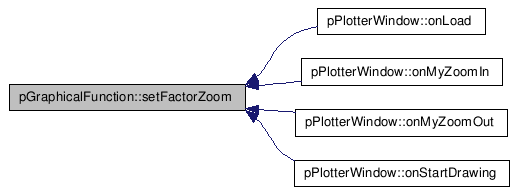
| void pGraphicalFunction::setEditable | ( | bool | edit | ) | [inline] |
Definition at line 607 of file pGraphicalFunction.h.
References editable.
Referenced by HistogramWidget::drawHistogram(), and Histogram::drawHistogram().
00608 { 00609 editable=edit; 00610 }

| bool pGraphicalFunction::getEditable | ( | ) | [inline] |
Get editable
Definition at line 614 of file pGraphicalFunction.h.
References editable.
Referenced by pPlotterWindow::onChangeActual(), and pPlotterWindow::onMouseMove().
00615 { 00616 return editable; 00617 }

| bool pGraphicalFunction::getZoomB | ( | ) | [inline] |
Definition at line 626 of file pGraphicalFunction.h.
References zoomIn.
00627 { 00628 return zoomIn; 00629 }
| void pGraphicalFunction::setZoomIn | ( | bool | z | ) | [inline] |
Definition at line 634 of file pGraphicalFunction.h.
References zoomIn.
00635 { 00636 zoomIn=z; 00637 }
| void pGraphicalFunction::setInitialDrawPoint | ( | pFunctionPoint * | initialPoint | ) | [inline] |
Set the initial drawing point
| pFunctionPoint* | initialPoint |
Definition at line 642 of file pGraphicalFunction.h.
References initialDrawingPoint.
00643 { 00644 initialDrawingPoint=initialPoint; 00645 }
| pFunctionPoint* pGraphicalFunction::getInitialDrawPoint | ( | ) | [inline] |
Get the initial drawing point
Definition at line 650 of file pGraphicalFunction.h.
References initialDrawingPoint.
00651 { 00652 return initialDrawingPoint; 00653 }
| void pGraphicalFunction::setFinalDrawPoint | ( | pFunctionPoint * | finalPoint | ) | [inline] |
Set the final drawing point
| pFunctionPoint* | finalPoint |
Definition at line 658 of file pGraphicalFunction.h.
References finalDrawingPoint.
00659 { 00660 finalDrawingPoint=finalPoint; 00661 }
| pFunctionPoint* pGraphicalFunction::getFinallDrawPoint | ( | ) | [inline] |
Get the final drawing point
Definition at line 666 of file pGraphicalFunction.h.
References finalDrawingPoint.
00667 { 00668 return finalDrawingPoint; 00669 }
| void pGraphicalFunction::zooming | ( | int | clickedX, | |
| int | clickedY, | |||
| int | width | |||
| ) |
This method set the initial point and the final point of drawing according with the width of the square around the point clicked
| clickedX | ||
| clickedY | ||
| width,: | width of the square |
| clickedX | ||
| clickedY | ||
| width,: | width of the square Note: all the parameters are pixels Pre: screenX, screenY, zoom are set! with the actual data. DEPRECATED! |
Definition at line 440 of file pGraphicalFunction.cxx.
References _offsetX, _offsetY, _scaleX, _scaleY, finalDrawingPoint, pLogicalFunction::GetPointAt(), pFunctionPoint::getRealX(), pFunctionPoint::getRealY(), getSizePoints(), initialDrawingPoint, logicFunction, setScales(), and zoomIn.
00441 { 00442 int xS,yS,x1,x2,y1,y2; 00443 setScales(); 00444 xS=clickedX/_scaleX+_offsetX; 00445 yS=clickedY/_scaleY+_offsetY; 00446 //square 00447 x1=(clickedX-width)/_scaleX+_offsetX; 00448 x2=(clickedX+width)/_scaleX+_offsetX; 00449 y1=(clickedY-width)/_scaleY+_offsetY; 00450 y2=(clickedY+width)/_scaleY+_offsetY; 00451 00452 int numberPoints=getSizePoints(); 00453 pFunctionPoint* point; 00454 wxNode* p; 00455 bool inSquare=false,first=false; 00456 00457 //if the user made a zoom 00458 if(zoomIn) 00459 { 00460 int i; 00461 for(i=0; i<numberPoints;i++) 00462 { 00463 p=logicFunction->GetPointAt(i); 00464 point=(pFunctionPoint*)p->GetData(); 00465 int rx=point->getRealX(); 00466 int ry=point->getRealY(); 00467 inSquare= rx>=x1 && rx<=x2; //&& ry>=y1 && ry<=y2; 00468 if(inSquare) 00469 { 00470 if(!first) 00471 { 00472 initialDrawingPoint=point; 00473 _offsetX=rx; 00474 _offsetY=ry; 00475 first=true; 00476 } 00477 finalDrawingPoint=point; 00478 } 00479 } 00480 } 00481 else 00482 { 00483 //We extend the range of vision in x and y,20 and 10 respectively 00484 if((_offsetX-20)>=0) 00485 { 00486 _offsetX=_offsetX-20; 00487 } 00488 else 00489 _offsetX=0; 00490 if((_offsetY-10)>=0) 00491 { 00492 _offsetY=_offsetY-10; 00493 } 00494 else 00495 _offsetY=0; 00496 } 00497 }
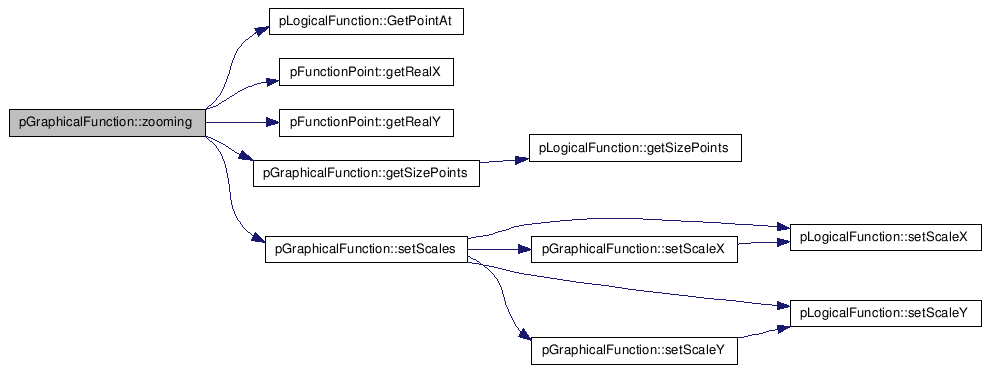
| void pGraphicalFunction::setOffsets | ( | int | offx, | |
| int | offy | |||
| ) |
Definition at line 508 of file pGraphicalFunction.cxx.
References _offsetX, _offsetY, _scaleX, _scaleY, minShowedX, minShowedY, offsetPixelX, offsetPixelY, setOffsetPixelX(), setOffsetPixelY(), setOffsetX(), setOffsetY(), and setScales().
Referenced by pPlotterWindow::onMyZoomIn(), and pPlotterWindow::onMyZoomOut().
00509 { 00510 int xS,yS; 00511 00512 setScales(); 00513 00514 xS=(offx-offsetPixelX)/_scaleX+_offsetX + minShowedX; 00515 yS=(offy-offsetPixelY)/_scaleY+_offsetY+ minShowedY; 00516 00517 setOffsetX(xS); 00518 setOffsetY(yS); 00519 00520 //setMinShowedX(xS); 00521 //setMinShowedY(yS); 00522 00523 setOffsetPixelX(offx); 00524 setOffsetPixelY(offy); 00525 //setMinShowed(); 00526 }
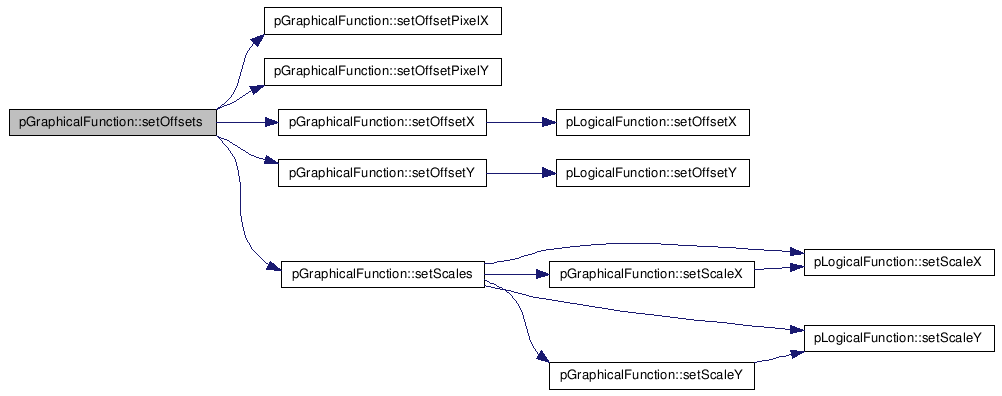

| void pGraphicalFunction::setMinShowed | ( | ) |
Definition at line 536 of file pGraphicalFunction.cxx.
References _offsetX, _offsetY, pLogicalFunction::GetPointAt(), pFunctionPoint::getRealX(), pFunctionPoint::getRealY(), logicFunction, node, setMinShowedX(), and setMinShowedY().
00537 { 00538 bool firstX=false,firstY=false; 00539 00540 wxNode* node=logicFunction->GetPointAt(0); 00541 pFunctionPoint* p; 00542 00543 //float middleWX=(((float)(screenX-100))/2)/scaleX; // JPRx 00544 //float middleWY=(((float)(screenY-50))/2)/scaleY; // JPRx 00545 00546 //node=node->GetNext(); 00547 while(node) 00548 { 00549 p=(pFunctionPoint*)node->GetData(); 00550 int px=p->getRealX(); 00551 int py=p->getRealY(); 00552 int x=(px-_offsetX);//+middleWX; 00553 int y=(py-_offsetY);//+middleWY; 00554 if(!firstX && x>=0) 00555 { 00556 firstX=true; 00557 setMinShowedX(px); 00558 } 00559 if(!firstY && y>=0) 00560 { 00561 firstY=true; 00562 setMinShowedY(py); 00563 } 00564 node=node->GetNext(); 00565 } 00566 }
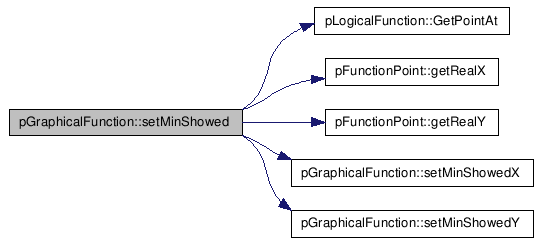
| int pGraphicalFunction::getMinXShowed | ( | ) | [inline] |
Get the minX Showed
Definition at line 696 of file pGraphicalFunction.h.
References minShowedX.
Referenced by getMinShowed(), pPlotterWindow::moveFunctions(), pPlotterWindow::onChangeActual(), pPlotter::onChangeFunction(), pPlotterWindow::setActualScales(), and pPlotter::setAll().
00697 { 00698 return minShowedX; 00699 }
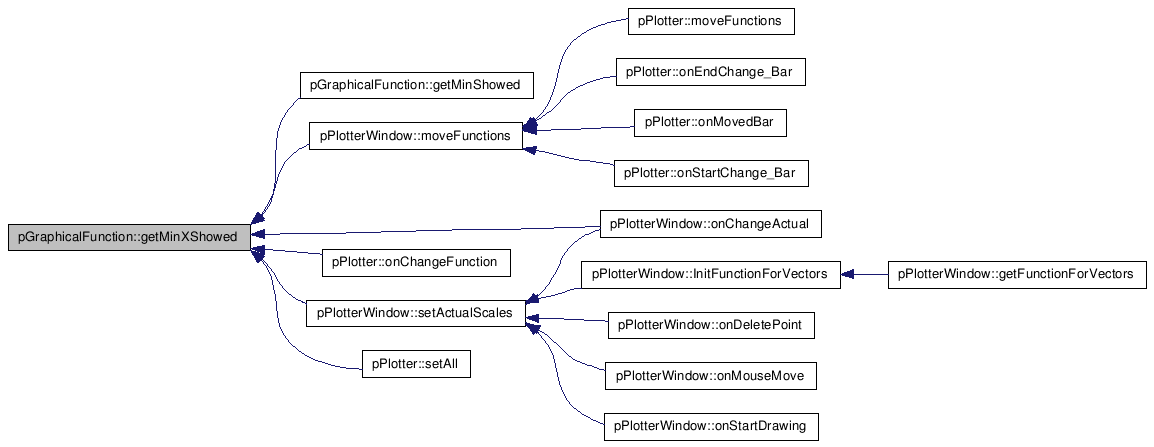
| int pGraphicalFunction::getMinYShowed | ( | ) | [inline] |
Get the minY Showed
Definition at line 703 of file pGraphicalFunction.h.
References minShowedY.
Referenced by getMinShowed(), pPlotterWindow::moveFunctions(), pPlotterWindow::onChangeActual(), and pPlotterWindow::setActualScales().
00704 { 00705 return minShowedY; 00706 }
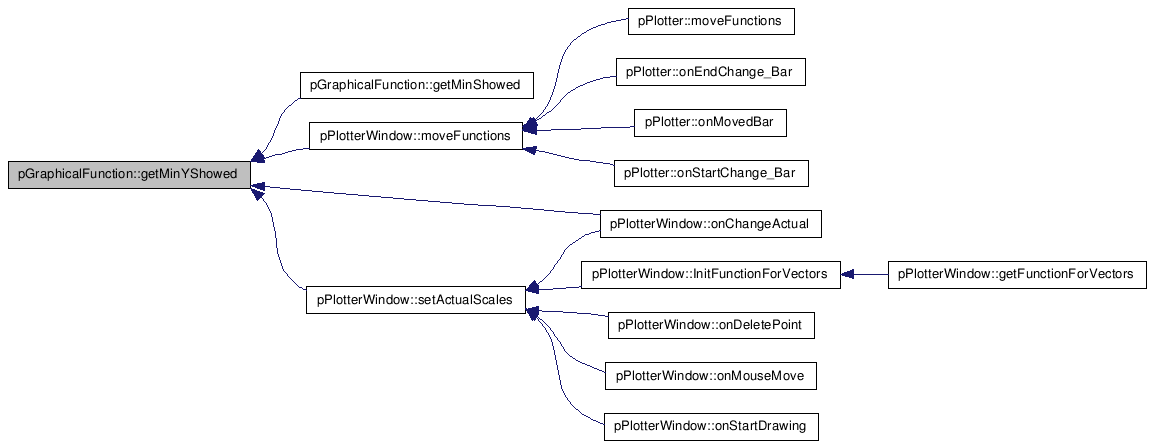
| int pGraphicalFunction::getMaxXShowed | ( | ) | [inline] |
Get the maxX Showed
Definition at line 710 of file pGraphicalFunction.h.
References maxShowedX.
Referenced by getMaxShowed(), pPlotterWindow::moveFunctions(), pPlotterWindow::onChangeActual(), pPlotter::onChangeFunction(), pPlotterWindow::setActualScales(), and pPlotter::setAll().
00711 { 00712 return maxShowedX; 00713 }
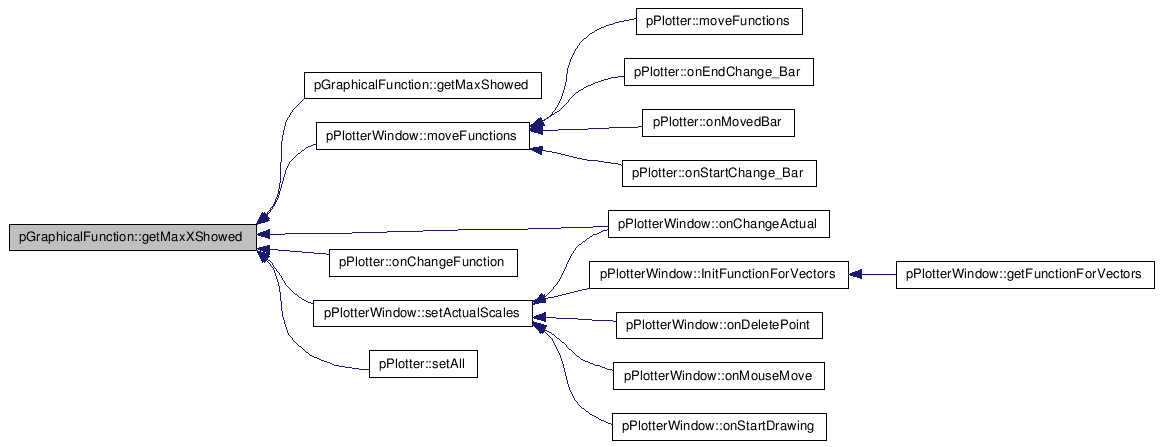
| int pGraphicalFunction::getMaxYShowed | ( | ) | [inline] |
Get the maxY Showed
Definition at line 717 of file pGraphicalFunction.h.
References maxShowedY.
Referenced by getMaxShowed(), pPlotterWindow::moveFunctions(), pPlotterWindow::onChangeActual(), and pPlotterWindow::setActualScales().
00718 { 00719 return maxShowedY; 00720 }
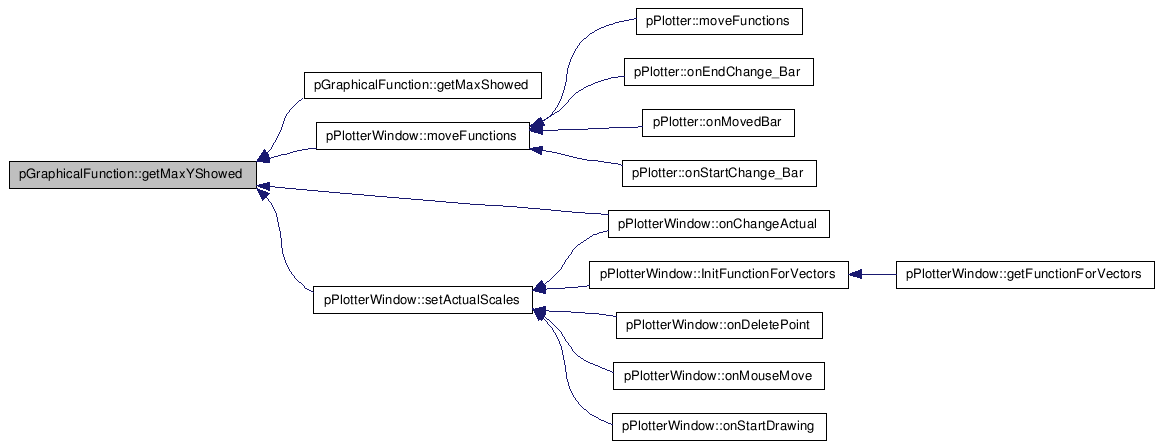
| void pGraphicalFunction::setMinShowedX | ( | int | msx | ) | [inline] |
Set the minShowedX
Definition at line 724 of file pGraphicalFunction.h.
References minShowedX.
Referenced by pPlotterWindow::actualizeViewRange(), pPlotterWindow::InitFunctionForVectors(), load(), pPlotterWindow::moveFunctions(), pPlotterWindow::onStartDrawing(), and setMinShowed().
00725 { 00726 minShowedX=msx; 00727 }
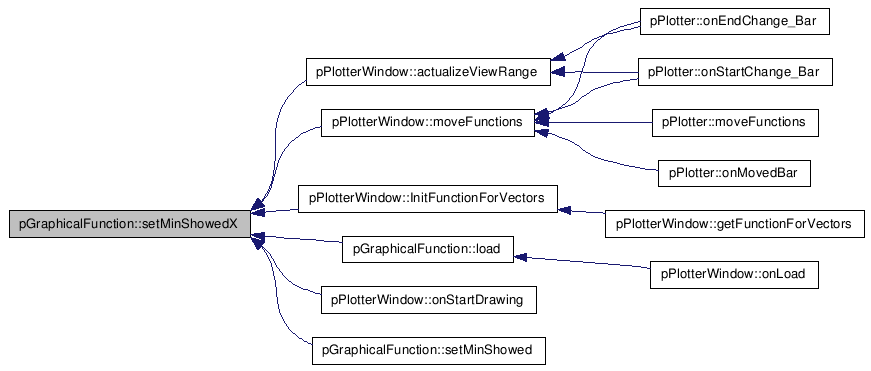
| void pGraphicalFunction::setMinShowedY | ( | int | msy | ) | [inline] |
Set the minShowedY
Definition at line 731 of file pGraphicalFunction.h.
References minShowedY.
Referenced by pPlotterWindow::InitFunctionForVectors(), load(), pPlotterWindow::onStartDrawing(), and setMinShowed().
00732 { 00733 minShowedY=msy; 00734 }

| void pGraphicalFunction::setMaxShowedX | ( | int | msx | ) | [inline] |
Set the maxShowedX
Definition at line 738 of file pGraphicalFunction.h.
References maxShowedX.
Referenced by pPlotterWindow::actualizeViewRange(), pPlotterWindow::InitFunctionForVectors(), load(), pPlotterWindow::moveFunctions(), and pPlotterWindow::onStartDrawing().
00739 { 00740 maxShowedX=msx; 00741 }
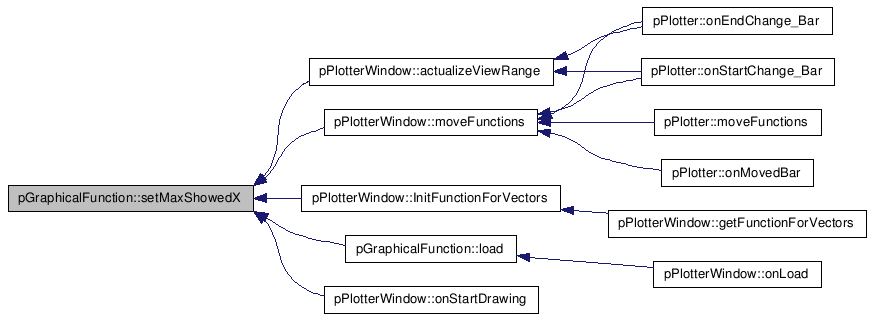
| void pGraphicalFunction::setMaxShowedY | ( | int | msy | ) | [inline] |
Set the minShowedY
Definition at line 745 of file pGraphicalFunction.h.
References maxShowedY.
Referenced by pPlotterWindow::InitFunctionForVectors(), load(), and pPlotterWindow::onStartDrawing().
00746 { 00747 maxShowedY=msy; 00748 }

| int pGraphicalFunction::getOffsetPixelsX | ( | ) | [inline] |
Gets the x-offset of the zoom in pixels
Definition at line 758 of file pGraphicalFunction.h.
References offsetPixelX.
Referenced by pPlotterWindow::onChangeActual(), pPlotterWindow::onMyZoomIn(), pPlotterWindow::onMyZoomOut(), and pPlotterWindow::onStartDrawing().
00759 { 00760 return offsetPixelX; 00761 }
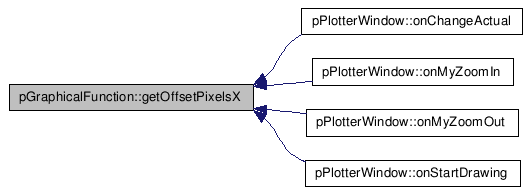
| int pGraphicalFunction::getOffsetPixelsY | ( | ) | [inline] |
Gets the offset of the zoom in pixels
Definition at line 767 of file pGraphicalFunction.h.
References offsetPixelY.
Referenced by pPlotterWindow::onChangeActual(), pPlotterWindow::onMyZoomIn(), pPlotterWindow::onMyZoomOut(), and pPlotterWindow::onStartDrawing().
00768 { 00769 return offsetPixelY; 00770 }
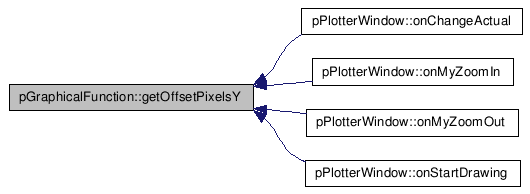
| void pGraphicalFunction::setOffsetPixelX | ( | int | offX | ) | [inline] |
Set the x-offset of the zoom
Definition at line 774 of file pGraphicalFunction.h.
References offsetPixelX.
Referenced by pPlotterWindow::onMyZoomIn(), pPlotterWindow::onMyZoomOut(), and setOffsets().
00775 { 00776 offsetPixelX=offX; 00777 }

| void pGraphicalFunction::setOffsetPixelY | ( | int | offY | ) | [inline] |
Set the y-offset of the zoom
Definition at line 781 of file pGraphicalFunction.h.
References offsetPixelY.
Referenced by pPlotterWindow::onMyZoomIn(), pPlotterWindow::onMyZoomOut(), and setOffsets().
00782 { 00783 offsetPixelY=offY; 00784 }

| void pGraphicalFunction::setColorPoints | ( | std::vector< pColorPoint * > & | colorVector | ) |
Definition at line 824 of file pGraphicalFunction.cxx.
References f_colorPoints.
00825 { 00826 f_colorPoints.clear(); 00827 int i = 0; 00828 while(i<(int)(colorVector.size())) 00829 { 00830 f_colorPoints.push_back(colorVector[i]); 00831 i++; 00832 } 00833 }
| void pGraphicalFunction::getColorPoints | ( | std::vector< pColorPoint * > & | colorVector | ) |
Definition at line 839 of file pGraphicalFunction.cxx.
References f_colorPoints, pColorPoint::getColor(), pColorPoint::getRealX(), and pColorPoint::isTemporalColor().
00840 { 00841 int i = 0; 00842 while(i<(int)(f_colorPoints.size())) 00843 { 00844 pColorPoint * originaslPoint = f_colorPoints[i]; 00845 pColorPoint * copyPoint = new pColorPoint(originaslPoint->getRealX(), originaslPoint->getColor(), originaslPoint->isTemporalColor()); 00846 colorVector.push_back(copyPoint); 00847 i++; 00848 } 00849 }

| void pGraphicalFunction::setmType | ( | int | mt | ) | [inline] |
Definition at line 802 of file pGraphicalFunction.h.
References mType.
Referenced by HistogramWidget::drawHistogram(), and Histogram::drawHistogram().
00803 { 00804 mType=mt; 00805 }

| void pGraphicalFunction::setXTraslation | ( | int | xT | ) | [inline] |
Set the value of the traslation in the x-axis
| xT | value in pixels of the traslation in x-axis |
Definition at line 814 of file pGraphicalFunction.h.
References xTraslation.
00815 { 00816 xTraslation=xT; 00817 }
| bool pPlotterLayer::initializePolygon | ( | wxPoint * | points, | |
| double | x1, | |||
| double | y1, | |||
| double | x2, | |||
| double | y2 | |||
| ) | [inherited] |
Definition at line 192 of file pPlotterLayer.cxx.
Referenced by pPlotterLayer::drawFunction(), and pPlotterLayer::drawSplineCurve().
00193 { 00194 bool setted=false; 00195 00196 //intercepts 00197 float m=((float)(y2-y1))/(x2-x1); 00198 float x0=-y1/m+x1; 00199 float y0=-m*x1+y1; 00200 00201 if(points[0].x<=0&& points[1].x<=0 && points[0].y<=0&& points[1].y<=0) 00202 { 00203 00204 //int offsetpx=getOffsetPixelsXv(); //JPRx 00205 00206 //analyzing the curve 00207 00208 if(x1<=0 && x2>=0) 00209 { 00210 if(y2>=0 && y1>=0) 00211 { 00212 //dc.DrawLine(0,y0, x2,y2); 00213 points[0].x=0; 00214 points[0].y=y0; 00215 points[1].x=x2; 00216 points[1].y=y2; 00217 setted=true; 00218 00219 } 00220 else if(y2<=0 && y1>=0) 00221 { 00222 if(y0>=0 && x0>=0) 00223 { 00224 //dc.DrawLine(0,y0,x0,0 ); 00225 points[0].x=0; 00226 points[0].y=y0; 00227 points[1].x=x0; 00228 points[1].y=0; 00229 setted=true; 00230 00231 } 00232 00233 } 00234 else if(y2>=0 && y1<=0) 00235 { 00236 if(y0>=0) 00237 { 00238 //dc.DrawLine(0,y0,x2,y2 ); 00239 points[0].x=0; 00240 points[0].y=y0; 00241 points[1].x=x2; 00242 points[1].y=y2; 00243 setted=true; 00244 } 00245 } 00246 00247 } 00248 00249 if(x1>=0 && x2>=0) 00250 { 00251 if(y1>=0 && y2>=0 ) 00252 { 00253 //dc.DrawLine(x1,y1, x2,y2); 00254 points[0].x=x1; 00255 points[0].y=y1; 00256 points[1].x=x2; 00257 points[1].y=y2; 00258 setted=true; 00259 } 00260 else if(y1>=0 && y2<=0) 00261 { 00262 //dc.DrawLine(x1,y1,x0,0 ); 00263 points[0].x=x1; 00264 points[0].y=y1; 00265 points[1].x=x0; 00266 points[1].y=0; 00267 setted=true; 00268 } 00269 else if(y1<=0 && y2>=0) 00270 { 00271 //dc.DrawLine(x0,0,x2,y2); 00272 points[0].x=x0; 00273 points[0].y=0; 00274 points[1].x=x2; 00275 points[1].y=y2; 00276 setted=true; 00277 } 00278 } 00279 else 00280 return setted; 00281 } 00282 else 00283 return setted; 00284 return setted; 00285 }

| void pPlotterLayer::draw | ( | wxDC & | dc, | |
| mpWindow & | w, | |||
| double | x1, | |||
| double | y1, | |||
| double | x2, | |||
| double | y2, | |||
| int | orgy | |||
| ) | [inherited] |
Definition at line 44 of file pPlotterLayer.cxx.
References mpLayer::GetYTranslated().
Referenced by pPlotterLayer::drawFunction(), and pPlotterLayer::drawSplineCurve().
00045 { 00046 00047 //intercepts 00048 float m=((float)(y2-y1))/(x2-x1); 00049 float x0=-y1/m+x1; 00050 float y0=-m*x1+y1; 00051 00052 double sizedc = dc.GetSize().GetHeight()-orgy; 00053 00054 //analyzing the curve 00055 00056 if(x1<=0 && x2>=0) 00057 { 00058 if(y2>=0 && y1>=0) 00059 dc.DrawLine(0,GetYTranslated(sizedc,y0), x2,GetYTranslated(sizedc,y2)); 00060 00061 else if(y2<=0 && y1>=0) 00062 { 00063 if(y0>=0 && x0>=0) 00064 dc.DrawLine(0,GetYTranslated(sizedc,y0),x0,GetYTranslated(sizedc,0) ); 00065 } 00066 else if(y2>=0 && y1<=0) 00067 { 00068 if(y0>=0) 00069 dc.DrawLine(0,GetYTranslated(sizedc,y0),x2,GetYTranslated(sizedc,y2) ); 00070 } 00071 00072 } 00073 00074 if(x1>=0 && x2>=0) 00075 { 00076 if(y1>=0 && y2>=0 ) 00077 dc.DrawLine(x1,GetYTranslated(sizedc,y1), x2,GetYTranslated(sizedc,y2)); 00078 else if(y1>=0 && y2<=0) 00079 dc.DrawLine(x1,GetYTranslated(sizedc,y1),x0,GetYTranslated(sizedc,0) ); 00080 else if(y1<=0 && y2>=0) 00081 dc.DrawLine(x0,GetYTranslated(sizedc,0),x2,GetYTranslated(sizedc,y2)); 00082 } 00083 00084 00085 }


| void pPlotterLayer::drawSplineCurve | ( | wxDC & | dc, | |
| mpWindow & | w, | |||
| int | orgy | |||
| ) | [inherited] |
Draw the function with th spline points
Definition at line 91 of file pPlotterLayer.cxx.
References pPlotterLayer::draw(), pPlotterLayer::getMaxShowed(), pPlotterLayer::getMinShowed(), pPlotterLayer::getmType(), pPlotterLayer::getOffsetPixelsXv(), pPlotterLayer::getOffsetPixelsYv(), pPlotterLayer::getXSpline(), pPlotterLayer::getYSpline(), mpLayer::GetYTranslated(), pPlotterLayer::initializePolygon(), pPlotterLayer::offsetX, pPlotterLayer::offsetY, pPlotterLayer::scaleX, and pPlotterLayer::scaleY.
Referenced by pPlotterLayer::Plot().
00092 { 00093 std::vector<double> vx=getXSpline(); 00094 std::vector<double> vy=getYSpline(); 00095 wxPoint* ppoints; 00096 00097 int /*counter=0,*/ minX,maxX,minY,maxY; // JPRx 00098 /* 00099 This is the offset of every point scale to the window 00100 pixel 00101 */ 00102 int offsetpx=getOffsetPixelsXv(); 00103 int offsetpy=getOffsetPixelsYv(); 00104 00105 // type of plotter 00106 int type=getmType(); 00107 00108 wxPoint point; 00109 /***********/ 00110 getMaxShowed(maxX,maxY); 00111 getMinShowed(minX,minY); 00112 /***********/ 00113 00114 00115 if(type==2) 00116 { 00117 /* 00118 Fill the function if it represented an histogram 00119 */ 00120 ppoints=(wxPoint*)malloc(sizeof(int)*2*(vx.size()+2)); 00121 //initialize points 00122 point.x=-5000; 00123 point.y=-5000; 00124 ppoints[0]=point; 00125 ppoints[1]=point; 00126 } 00127 00128 int size=vx.size(); 00129 int j=2; 00130 00131 for(int i=0;(i+1)< size;i++) 00132 { 00133 00134 00135 double cxi=(vx.at(i)-minX-offsetX)*scaleX+offsetpx; 00136 double cyi=(vy.at(i)-minY-offsetY)*scaleY+offsetpy; 00137 00138 double cxj=(vx.at(i+1)-minX-offsetX)*scaleX+offsetpx; 00139 double cyj=(vy.at(i+1)-minY-offsetY)*scaleY+offsetpy; 00140 00141 00142 if(type!=2) 00143 draw(dc,w,cxi,cyi,cxj,cyj,orgy); 00144 else if(type==2) 00145 { 00146 if(!initializePolygon(ppoints,cxi,cyi,cxj,cyj) && ((cxi<=0 && cxj>=0)||(cxi>=0 && cxj>=0))) 00147 { 00148 point.x=cxj; 00149 point.y=cyj; 00150 ppoints[j]=point; 00151 j++; 00152 00153 } 00154 } 00155 00156 } 00157 if(type==2) 00158 { 00159 //point.x=vx.at(size-1)* scaleX + offsetpx; 00160 point.x=ppoints[j-1].x; 00161 point.y=0; 00162 //ppoints[vx.size()]=point; 00163 ppoints[j]=point; 00164 /* 00165 Fill the function if it represented an histogram 00166 */ 00167 //ppoints=(wxPoint*)malloc(sizeof(int)*2*(vx.size()+1)); 00168 //settings for fill 00169 //point.x=vx.at(0)*scaleX + offsetpx; 00170 point.x=ppoints[0].x; 00171 point.y=0; 00172 //ppoints[vx.size()+1]=point; 00173 ppoints[j+1]=point; 00174 00175 dc.SetBrush(wxBrush( wxColour(239,238,242) ,wxSOLID )); 00176 dc.SetPen(wxPen( wxColour(0,0,0) ,1,wxSOLID )); 00177 //dc.DrawPolygon(vx.size()+2,ppoints,0,0); 00178 for(int i = 0; i <= j + 1; i++){ 00179 int sizedc = dc.GetSize().GetHeight()-orgy; 00180 ppoints[i].y = GetYTranslated(sizedc, ppoints[i].y); 00181 } 00182 dc.DrawPolygon(j+2,ppoints,0,0); 00183 } 00184 00185 00186 }
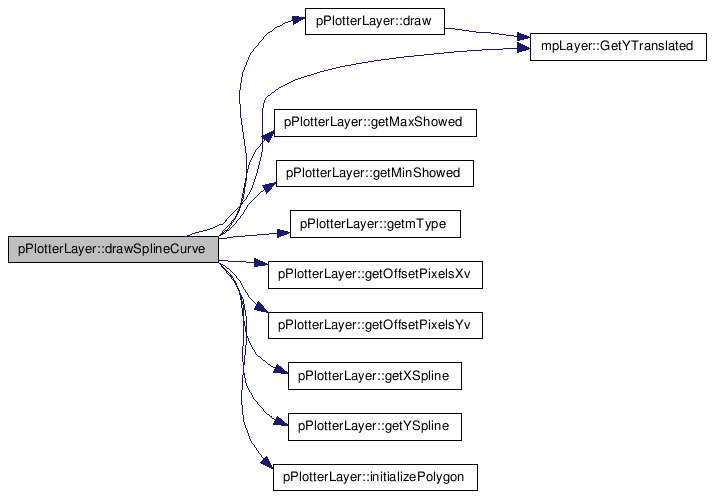

| void pPlotterLayer::drawLineToMousePoint | ( | wxDC & | dc, | |
| mpWindow & | w, | |||
| int | orgy | |||
| ) | [inherited] |
Draw the line between the last point of the function and the position of the mouse
Definition at line 461 of file pPlotterLayer.cxx.
References mpWindow::drawGuideLines(), pPlotterLayer::getDirection(), pPlotterLayer::getMaxShowed(), pPlotterLayer::getMinShowed(), pPlotterLayer::getMousePoint(), pPlotterLayer::getOffsetPixelsXv(), pPlotterLayer::getOffsetPixelsYv(), pPlotterLayer::GetPoints(), pFunctionPoint::getRealX(), pFunctionPoint::getRealY(), pPlotterLayer::getSize(), pPlotterLayer::offsetX, pPlotterLayer::offsetY, pPlotterLayer::points, pPlotterLayer::Rewind(), pPlotterLayer::scaleX, and pPlotterLayer::scaleY.
Referenced by pPlotterLayer::Plot().
00462 { 00463 int x,y,sizeP,maxX,maxY,minX,minY; 00464 bool direction; 00465 00466 Rewind(); 00467 00468 getMousePoint(x,y); 00469 getDirection(direction); 00470 getSize(sizeP); 00471 //Lines betwen the points 00472 GetPoints(points); 00473 00474 wxNode *node=points.GetLast(); 00475 wxNode *node1=points.GetFirst(); 00476 00477 00478 /* 00479 This is the offset of every point scale to the window 00480 pixel 00481 */ 00482 int offsetpx = getOffsetPixelsXv(); 00483 int offsetpy = getOffsetPixelsYv(); 00484 /***********/ 00485 getMaxShowed(maxX,maxY); 00486 getMinShowed(minX,minY); 00487 /***********/ 00488 //traslation 00489 // int xTraslation=getXTraslation(); //EED 00490 00491 if(node) 00492 { 00493 pFunctionPoint* lastPoint=(pFunctionPoint*)node->GetData(); 00494 pFunctionPoint* firstPoint=(pFunctionPoint*)node1->GetData(); 00495 00496 //LeftDrawing 00497 if(lastPoint->getRealX()<x && direction && sizeP >=2) 00498 00499 dc.DrawLine((lastPoint->getRealX()-minX-offsetX)*scaleX + offsetpx,(lastPoint->getRealY()-minY-offsetY)*scaleY+ offsetpy, (x-minX)*scaleX + offsetpx, (y-minY)*scaleY + offsetpy); 00500 00501 //right drawing 00502 else if(firstPoint->getRealX()>x && !direction && sizeP >=2 ) 00503 00504 dc.DrawLine((firstPoint->getRealX()-minX-offsetX)*scaleX+ offsetpx,(firstPoint->getRealY()-minY-offsetY)*scaleY+ offsetpy,(x-minX)*scaleX+ offsetpx, (y-minY)*scaleY+ offsetpy); 00505 00506 //just a point 00507 else if(sizeP==1 ) 00508 { 00509 dc.DrawLine((lastPoint->getRealX()-minX-offsetX)*scaleX + offsetpx,(lastPoint->getRealY()-minY-offsetY)*scaleY+ offsetpy, (x-minX)*scaleX+ offsetpx, (y-minY)*scaleY+ offsetpy); 00510 } 00511 } 00512 00513 if( w.drawGuideLines() ) 00514 { 00515 dc.SetPen(wxPen( wxColour(255,0,0),1,wxDOT )); 00516 // Drawing the horizontal guide line 00517 dc.DrawLine( 0, (y-minY)*scaleY + offsetpy, (x-minX)*scaleX + offsetpx, (y-minY)*scaleY + offsetpy); 00518 // Drawing the vertical guide line 00519 dc.DrawLine( (x-minX)*scaleX + offsetpx,0, (x-minX)*scaleX + offsetpx, (y-minY)*scaleY + offsetpy); 00520 } 00521 }
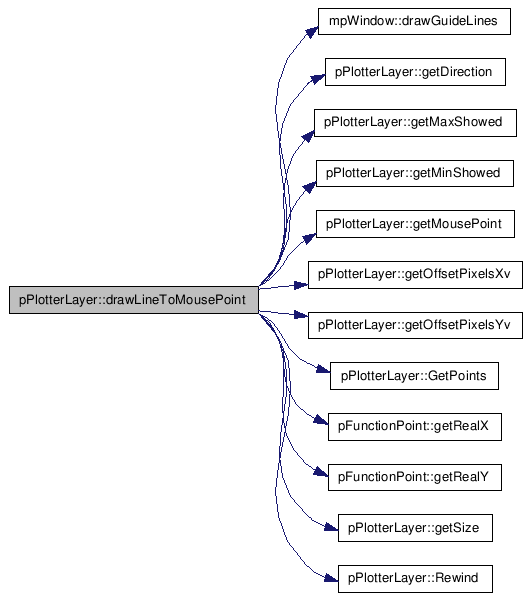

| void pPlotterLayer::drawFunction | ( | wxDC & | dc, | |
| mpWindow & | w, | |||
| int | orgy | |||
| ) | [inherited] |
Draw le lines between the points of the function
Draw the lines between the points of the function
Definition at line 290 of file pPlotterLayer.cxx.
References pPlotterLayer::draw(), pPlotterLayer::getMaxShowed(), pPlotterLayer::getMinShowed(), pPlotterLayer::getmType(), pPlotterLayer::getOffsetPixelsXv(), pPlotterLayer::getOffsetPixelsYv(), pPlotterLayer::GetPoints(), pFunctionPoint::getRealX(), pFunctionPoint::getRealY(), mpLayer::GetYTranslated(), pPlotterLayer::initializePolygon(), pPlotterLayer::offsetX, pPlotterLayer::offsetY, pPlotterLayer::points, pPlotterLayer::Rewind(), pPlotterLayer::scaleX, and pPlotterLayer::scaleY.
Referenced by pPlotterLayer::Plot().
00291 { 00292 00293 00294 int scrwX,scrwY,offsetpx,offsetpy,maxX,minX,maxY,minY; 00295 wxPoint* ppoints=NULL; 00296 00297 /* 00298 This is the offset of every point scale to the window 00299 pixel 00300 */ 00301 offsetpx=getOffsetPixelsXv(); 00302 offsetpy=getOffsetPixelsYv(); 00303 00304 Rewind(); 00305 00306 dc.GetSize(&scrwX, &scrwY); 00307 00308 //Lines between the points 00309 00310 int sizedc = dc.GetSize().GetHeight()-orgy; 00311 00312 GetPoints(points); 00313 00314 // type of plotter 00315 int type=getmType(); 00316 /***********/ 00317 getMaxShowed(maxX,maxY); 00318 getMinShowed(minX,minY); 00319 /***********/ 00320 00321 //traslation 00322 //int xTraslation=getXTraslation(); //JPRx 00323 wxNode* node= points.GetFirst(); 00324 // int i=1;//points.GetCount()+1; //JPRx 00325 int j=2; 00326 /* 00327 Fill it if it is an histogram 00328 */ 00329 wxPoint point; 00330 // pFunctionPoint* pointk; //JPRx 00331 if(type==2) 00332 { 00333 /* 00334 Fill the function if it represented an histogram 00335 */ 00336 ppoints=(wxPoint*)malloc(sizeof(int)*2*(points.GetCount()+2)); 00337 //initialize points 00338 point.x=-5000; 00339 point.y=GetYTranslated(sizedc,-5000); 00340 ppoints[0]=point; 00341 ppoints[1]=point; 00342 00343 } 00344 00345 00346 while (node!=NULL && node->GetNext()!=NULL) 00347 { 00348 pFunctionPoint* pointi=(pFunctionPoint*)node->GetData(); 00349 wxNode* nextNode=node->GetNext(); 00350 pFunctionPoint* pointj=(pFunctionPoint*)nextNode->GetData(); 00351 00352 // we do the offset 00353 int pxi=(pointi->getRealX()-minX)-offsetX; 00354 int pyi=(pointi->getRealY()-minY)-offsetY; 00355 int pxj=(pointj->getRealX()-minX)-offsetX; 00356 int pyj=(pointj->getRealY()-minY)-offsetY; 00357 00358 00359 int cxi=pxi* scaleX + offsetpx; //+ xTraslation; 00360 int cxj=pxj* scaleX + offsetpx; //+ xTraslation; 00361 int cyi=pyi* scaleY+ offsetpy ; 00362 int cyj=pyj* scaleY+ offsetpy ; 00363 //dc.DrawLine(pxi* scaleX + offsetpx,pyi* scaleY+ offsetpy, pxj* scaleX + offsetpx,pyj* scaleY+ offsetpy ); 00364 if(type!=2) 00365 draw(dc,w,pxi* scaleX + offsetpx,pyi* scaleY+ offsetpy, pxj* scaleX + offsetpx,pyj* scaleY+ offsetpy,orgy ); 00366 //dc.DrawLine(pxi* scaleX + offsetpx,pyi* scaleY+ offsetpy, pxj* scaleX + offsetpx,pyj* scaleY+ offsetpy ); 00367 else if(type==2) 00368 { 00369 if(!initializePolygon(ppoints,cxi,cyi,cxj,cyj) && ((cxi<=0 && cxj>=0)||(cxi>=0 && cxj>=0))) 00370 { 00371 point.x=cxj; 00372 point.y=GetYTranslated(sizedc,cyj); 00373 ppoints[j]=point; 00374 j++; 00375 00376 } 00377 } 00378 00379 node=node->GetNext(); 00380 00381 } 00382 if(type==2) 00383 { 00384 //point.x=vx.at(size-1)* scaleX + offsetpx; 00385 point.x=ppoints[j-1].x; 00386 point.y=GetYTranslated(sizedc,0); 00387 //ppoints[vx.size()]=point; 00388 ppoints[j]=point; 00389 /* 00390 Fill the function if it represented an histogram 00391 */ 00392 //ppoints=(wxPoint*)malloc(sizeof(int)*2*(vx.size()+1)); 00393 //settings for fill 00394 //point.x=vx.at(0)*scaleX + offsetpx; 00395 point.x=ppoints[0].x; 00396 point.y=GetYTranslated(sizedc,0); 00397 //ppoints[vx.size()+1]=point; 00398 ppoints[j+1]=point; 00399 00400 dc.SetBrush(wxBrush( wxColour(239,238,242) ,wxSOLID )); 00401 dc.SetPen(wxPen( wxColour(0,0,0) ,1,wxSOLID )); 00402 //dc.DrawPolygon(vx.size()+2,ppoints,0,0); 00403 dc.DrawPolygon(j+2,ppoints,0,0); 00404 00405 } 00406 00407 }
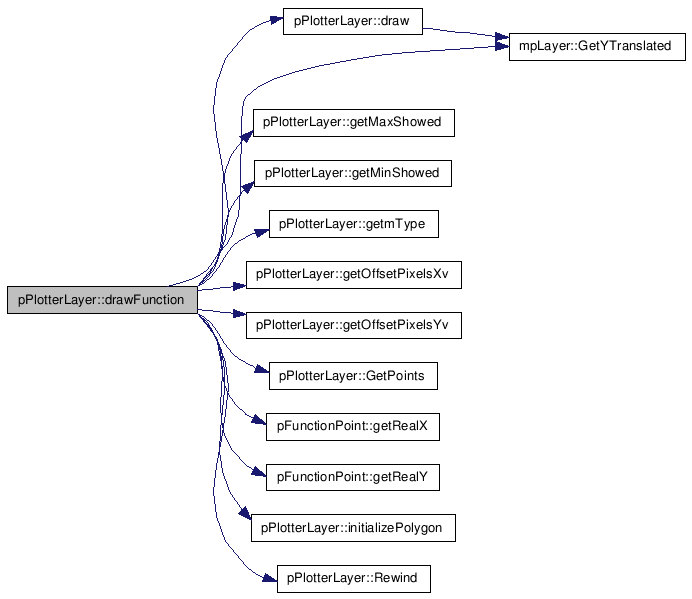

| void pPlotterLayer::drawPoints | ( | wxDC & | dc, | |
| mpWindow & | w, | |||
| int | orgy | |||
| ) | [inherited] |
Draw the points of the function
Definition at line 412 of file pPlotterLayer.cxx.
References pPlotterLayer::getMaxShowed(), pPlotterLayer::getMinShowed(), pPlotterLayer::GetNextXY(), pPlotterLayer::getOffsetPixelsXv(), pPlotterLayer::getOffsetPixelsYv(), mpLayer::GetYTranslated(), MOVE, pPlotterLayer::offsetX, pPlotterLayer::offsetY, pPlotterLayer::points, pPlotterLayer::Rewind(), pPlotterLayer::scaleX, and pPlotterLayer::scaleY.
Referenced by pPlotterLayer::Plot().
00413 { 00414 00415 Rewind(); 00416 double x, y; 00417 int minX,maxX,minY,maxY; 00418 00419 double sizedc = dc.GetSize().GetHeight()-orgy; 00420 00421 /* 00422 This is the offset of every point scale to the window 00423 pixel 00424 */ 00425 int offsetpx=getOffsetPixelsXv(); 00426 int offsetpy=getOffsetPixelsYv(); 00427 //traslation 00428 // int xTraslation=getXTraslation(); //EED 00429 /*wxPen mypen(*wxBLACK, 5, wxSOLID); 00430 dc.SetPen(mypen);*/ 00431 /***********/ 00432 getMaxShowed(maxX,maxY); 00433 getMinShowed(minX,minY); 00434 /***********/ 00435 //we have to draw the points 00436 00437 while (GetNextXY(x, y)) 00438 { 00439 //GetNextXY(x, y); 00440 //set the points of the polygons 00441 wxPoint points[4]; 00442 dc.SetBrush(wxBrush( wxColour(255,0,0),wxSOLID )); 00443 //dc.SetPen(wxPen(wxColour(0,0,0),1,wxSOLID) ); 00444 points[0].x=((x-minX-offsetX)*scaleX + offsetpx-MOVE); 00445 points[0].y=GetYTranslated(sizedc,((y-minY-offsetY)*scaleY+ offsetpy-MOVE)); 00446 points[1].x=((x-minX-offsetX)*scaleX+ offsetpx+MOVE); 00447 points[1].y=GetYTranslated(sizedc,((y-minY-offsetY)*scaleY+ offsetpy-MOVE)); 00448 points[2].x=((x-minX-offsetX)*scaleX+ offsetpx+MOVE); 00449 points[2].y=GetYTranslated(sizedc,((y-minY-offsetY)*scaleY+ offsetpy+MOVE)); 00450 points[3].x=((x-minX-offsetX)*scaleX+ offsetpx-MOVE); 00451 points[3].y=GetYTranslated(sizedc,((y-minY-offsetY)*scaleY+ offsetpy+MOVE)); 00452 if((x-minX-offsetX)*scaleX >=0 && (y-minY-offsetY/*w.getMinScrY()*/)*scaleY>=0) 00453 dc.DrawPolygon(4,points,0,0); 00454 } 00455 }
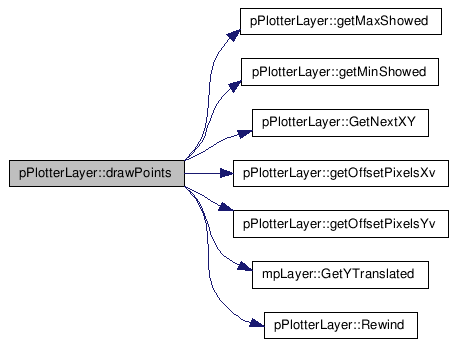

| void pPlotterLayer::Plot | ( | wxDC & | dc, | |
| mpWindow & | w | |||
| ) | [virtual, inherited] |
Layer plot handler. This implementation will plot the locus in the visible area and put a label according to the aligment specified.
Layer plot handler. This implementation will plot the locus in the visible area and put a label according to the aligment specified.
Implements mpLayer.
Reimplemented in pPlotterScaleX, and pPlotterScaleY.
Definition at line 529 of file pPlotterLayer.cxx.
References pPlotterLayer::drawFunction(), pPlotterLayer::drawLineToMousePoint(), pPlotterLayer::drawPoints(), pPlotterLayer::drawSplineCurve(), pPlotterLayer::getDrawing(), pPlotterLayer::getFactorZoom(), pPlotterLayer::getIfActual(), pPlotterLayer::getMaxShowed(), pPlotterLayer::getMinShowed(), pPlotterLayer::getOffsetPixelsXv(), pPlotterLayer::getOffsets(), mpWindow::getRealGuideX(), mpWindow::getRealGuideY(), mpLayer::GetYTranslated(), pPlotterLayer::ifShowPoints(), mpLayer::m_pen, pPlotterLayer::offsetX, pPlotterLayer::offsetY, pPlotterLayer::scaleX, pPlotterLayer::scaleY, mpWindow::SetScaleX(), mpWindow::SetScaleY(), and pPlotterLayer::vGetType().
00530 { 00531 bool show,drawing,actual; 00532 int scrwX,scrwY,maxX,maxY,minX,minY,type; 00533 float factorZoom; 00534 00535 ifShowPoints(show); 00536 getDrawing(drawing); 00537 type=vGetType(); 00538 00539 dc.SetPen( m_pen); 00540 00541 /* 00542 * Managing the scale and zoom 00543 */ 00544 00545 dc.GetSize(&scrwX, &scrwY); 00546 00547 getIfActual(actual); 00548 //getMax(maxX, maxY); 00549 /***********/ 00550 getMaxShowed(maxX,maxY); 00551 getMinShowed(minX,minY); 00552 /***********/ 00553 getFactorZoom(factorZoom); 00554 getOffsets(offsetX,offsetY); 00555 /* 00556 maxX=w.getMaxScrX(); 00557 maxY=w.getMaxScrY(); 00558 minX=w.getMinScrX(); 00559 minY=w.getMinScrY(); 00560 */ 00561 if((maxX-minX)!=0 && (maxY-minY)!=0) 00562 { 00563 00564 scaleX=(((double)scrwX-100)/(maxX-minX))*factorZoom; 00565 scaleY=(((double)scrwY-50)/(maxY-minY))*factorZoom; 00566 00567 if(actual) 00568 { 00569 w.SetScaleX(scaleX); 00570 w.SetScaleY(scaleY); 00571 //w.setMinScrX(offsetX); 00572 //w.setMinScrY(offsetY); 00573 } 00574 00575 } 00576 /* 00577 Managing the drawing 00578 */ 00579 int orgx=70; 00580 00581 00582 //EED 14Mai2009 00583 // int orgy=w.GetScrY()-40; 00584 // dc.SetDeviceOrigin( orgx ,orgy); 00585 // dc.SetAxisOrientation(true,true); 00586 00587 int orgy = 40; 00588 //dc.SetDeviceOrigin( orgx ,orgy); 00589 dc.SetDeviceOrigin( orgx ,0); 00590 int sizedc = dc.GetSize().GetHeight()-orgy; 00591 //dc.SetAxisOrientation(true,false); 00592 00593 00594 00595 //if the user dont want to see the points of the function and if he stops drawing 00596 //we have to draw the function 00597 if(!show && !drawing && type==1) 00598 drawFunction(dc,w,orgy); 00599 else if(!show && !drawing && type==2) 00600 drawSplineCurve(dc,w,orgy); 00601 //we just draw the point that the user just clicked 00602 else if(drawing && type==1) 00603 { 00604 drawFunction(dc,w,orgy); 00605 drawLineToMousePoint(dc,w,orgy); 00606 drawPoints(dc,w,orgy); 00607 } 00608 else if(drawing && type==1) 00609 { 00610 drawSplineCurve(dc,w,orgy); 00611 drawLineToMousePoint(dc,w,orgy); 00612 drawPoints(dc,w,orgy); 00613 } 00614 else if(show && type==1) 00615 { 00616 drawFunction(dc,w,orgy); 00617 drawPoints(dc,w,orgy); 00618 } 00619 else if(show && type==2) 00620 { 00621 drawSplineCurve(dc,w,orgy); 00622 drawPoints(dc,w,orgy); 00623 } 00624 00625 // Drawing the guides according to real values entered according to the integrated interaction (IS NOT WORKING!!!) 00626 if ( actual ) 00627 { 00628 dc.SetPen(wxPen( wxColour(255,0,0),1,wxDOT )); 00629 int offsetpx = getOffsetPixelsXv(); 00630 // int offsetpy = getOffsetPixelsYv(); //EED 00631 00632 int realX_guide = w.getRealGuideX(); 00633 if( realX_guide!=-1 ) 00634 { 00635 dc.DrawLine( (realX_guide/*-w.getMinScrX()*/-offsetX)*scaleX + offsetpx, 00636 GetYTranslated(sizedc,0), 00637 (realX_guide/*-w.getMinScrX()*/-offsetX)*scaleX + offsetpx, 00638 GetYTranslated(sizedc,scrwY)); 00639 } 00640 00641 int realY_guide = w.getRealGuideY(); 00642 if( realY_guide!=-1 ) 00643 { 00644 dc.DrawLine( 0, 00645 GetYTranslated(sizedc,(realY_guide/*-w.getMinScrY()*/-offsetX)*scaleX + offsetpx), 00646 scrwX, 00647 GetYTranslated(sizedc,(realY_guide/*-w.getMinScrY()*/-offsetX)*scaleX + offsetpx)); 00648 } 00649 } 00650 00651 }
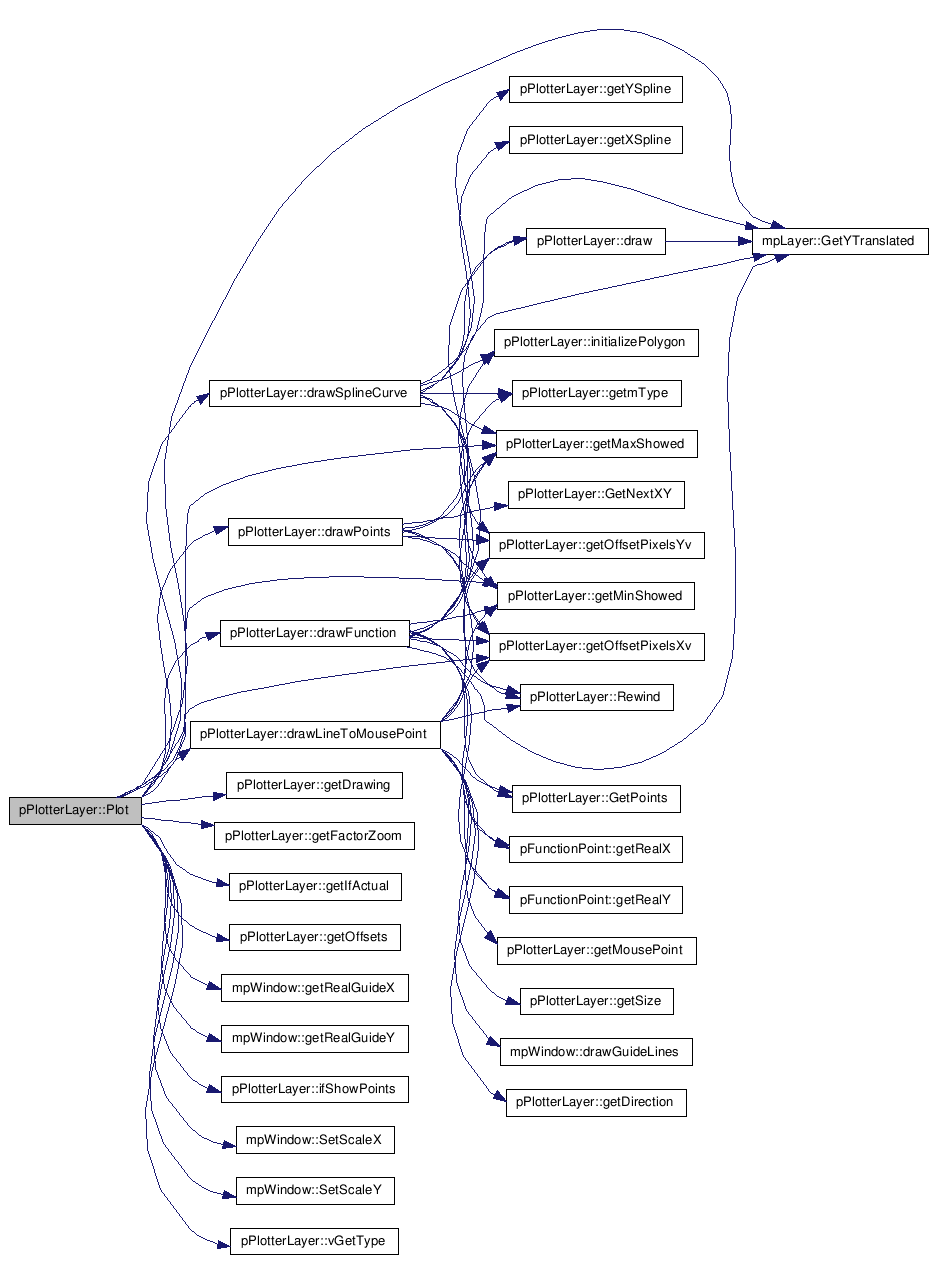
| virtual bool mpLayer::HasBBox | ( | ) | [inline, virtual, inherited] |
Check whether this layer has a bounding box. The default implementation returns TRUE. Overide and return FALSE if your mpLayer implementation should be ignored by the calculation of the global bounding box for all layers in a mpWindow.
| TRUE | Has bounding box | |
| FALSE | Has not bounding box |
Reimplemented in mpScaleX, mpScaleY, pPlotterScaleX, and pPlotterScaleY.
Definition at line 110 of file mathplot.h.
Referenced by mpWindow::UpdateBBox().
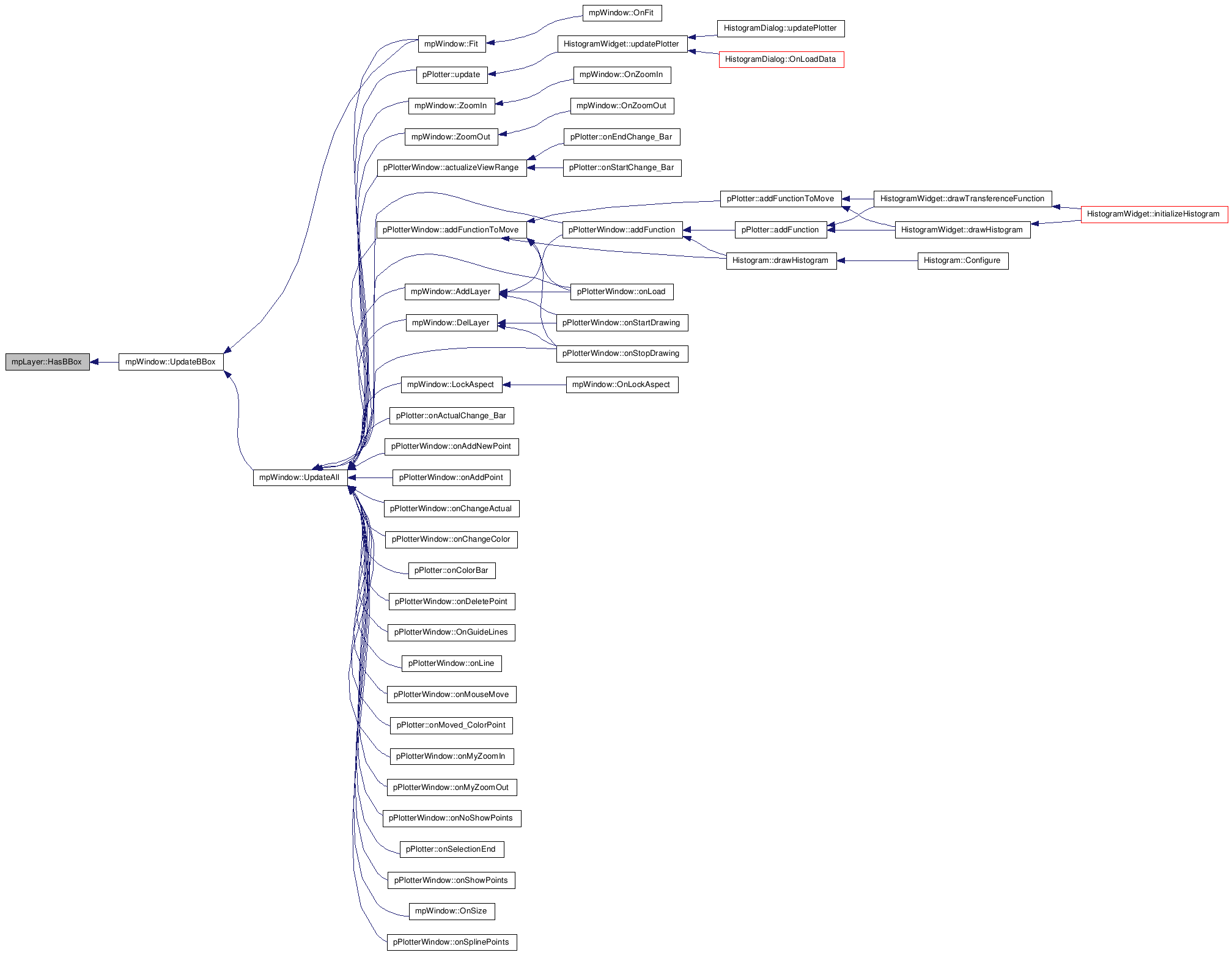
| virtual double mpLayer::GetMinX | ( | ) | [inline, virtual, inherited] |
Get inclusive left border of bounding box.
Definition at line 115 of file mathplot.h.
Referenced by mpWindow::UpdateBBox().
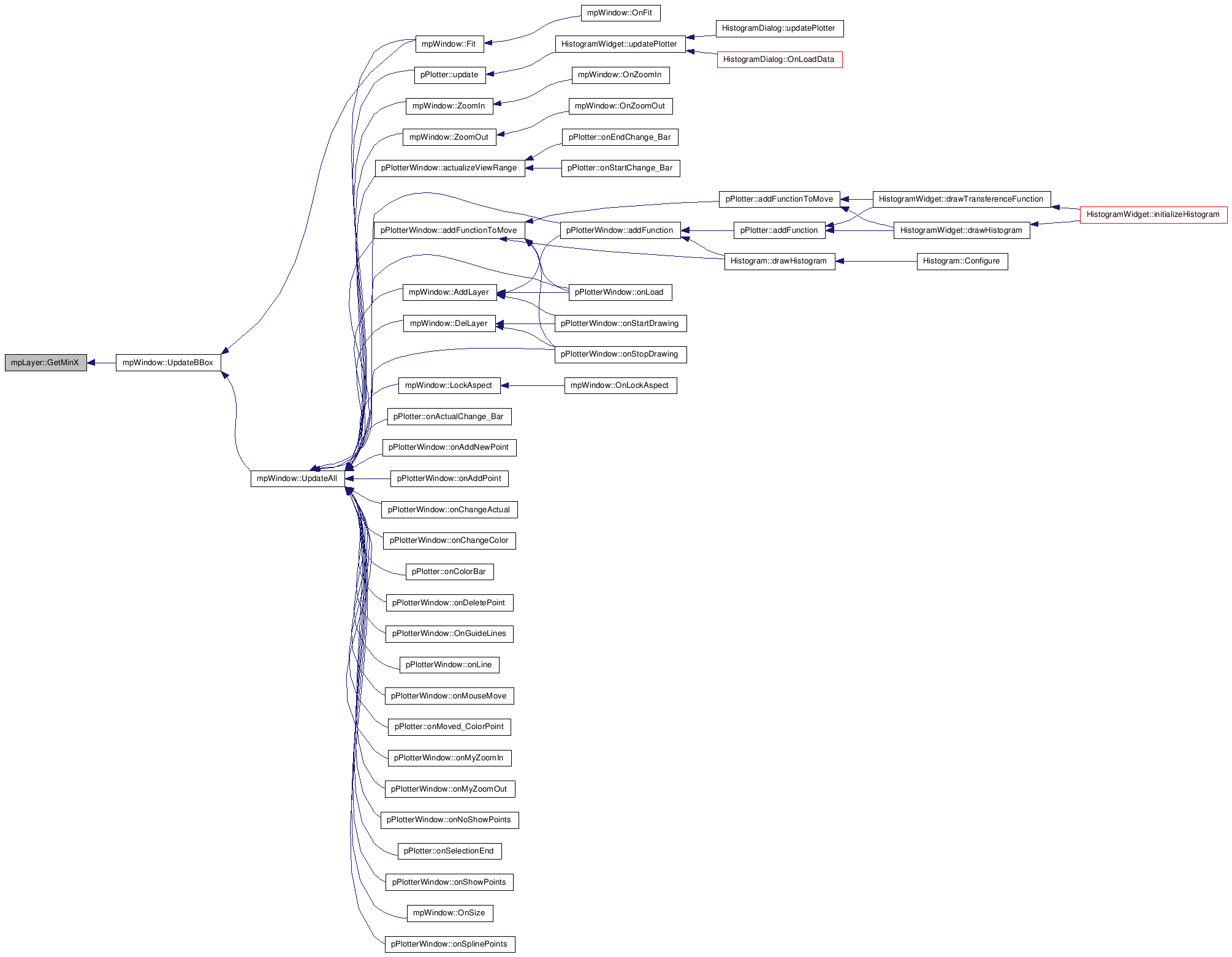
| virtual double mpLayer::GetMaxX | ( | ) | [inline, virtual, inherited] |
Get inclusive right border of bounding box.
Definition at line 120 of file mathplot.h.
Referenced by mpWindow::UpdateBBox().
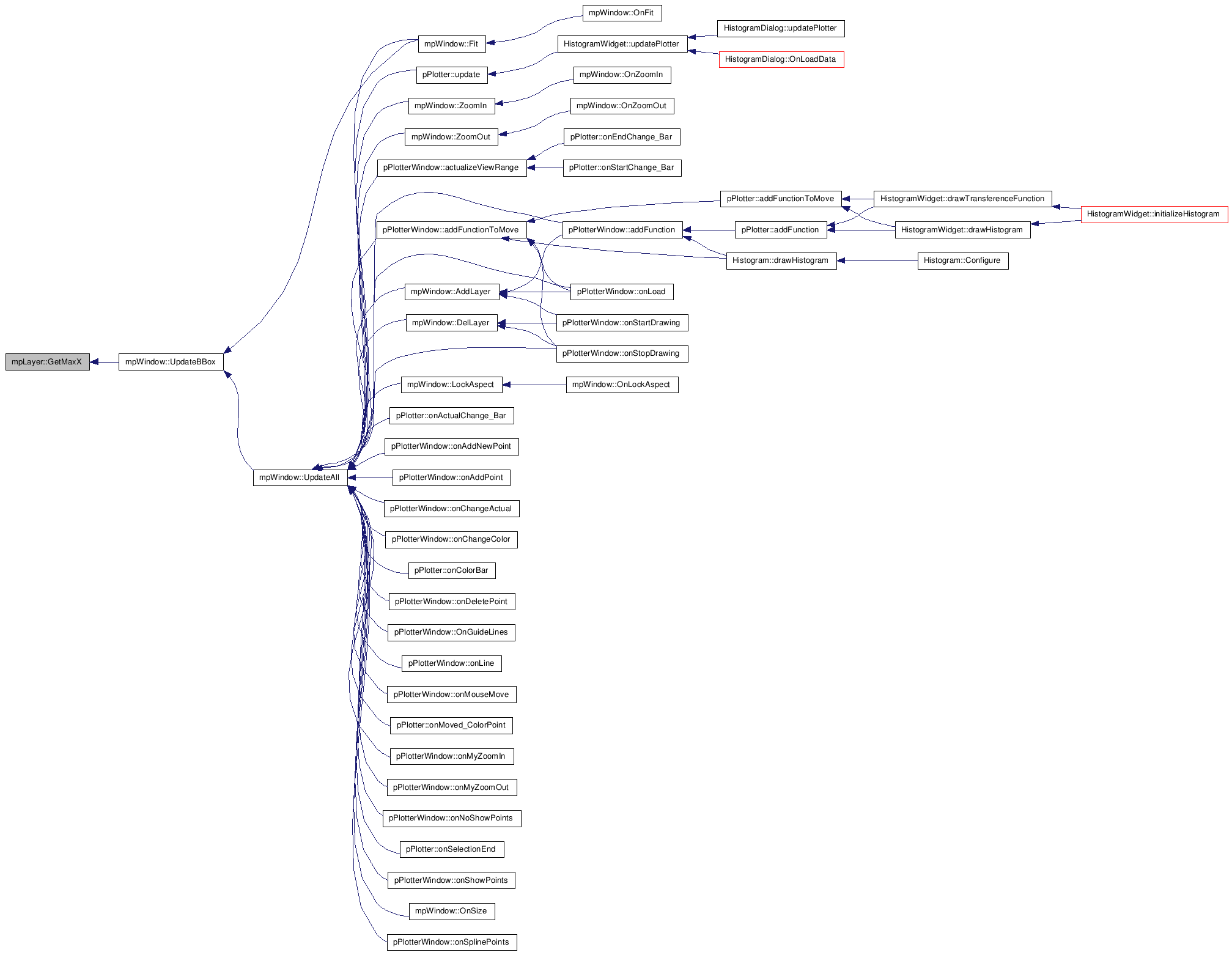
| virtual double mpLayer::GetMinY | ( | ) | [inline, virtual, inherited] |
Get inclusive bottom border of bounding box.
Definition at line 125 of file mathplot.h.
Referenced by mpWindow::UpdateBBox().
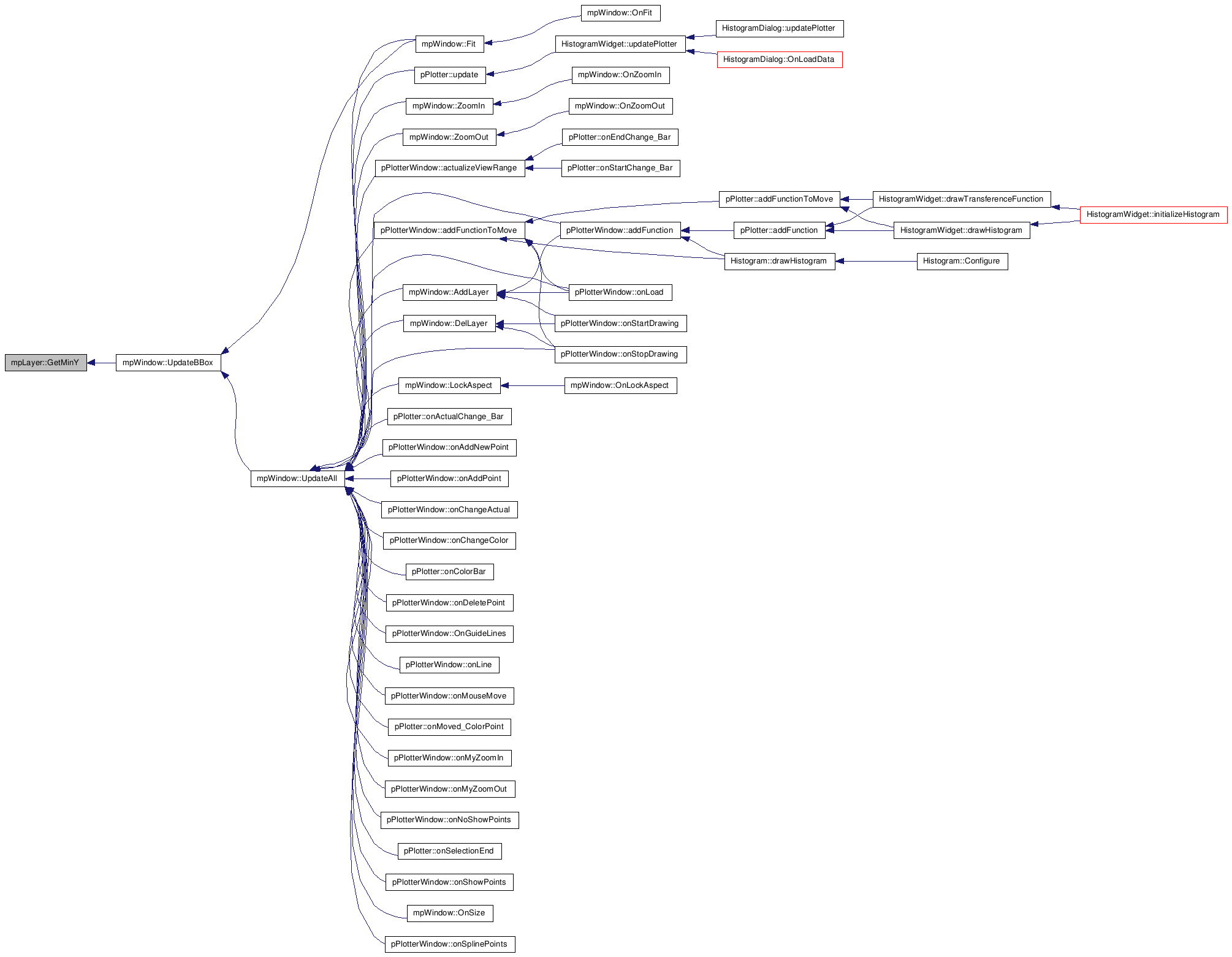
| virtual double mpLayer::GetMaxY | ( | ) | [inline, virtual, inherited] |
Get inclusive top border of bounding box.
Definition at line 130 of file mathplot.h.
Referenced by mpWindow::UpdateBBox().
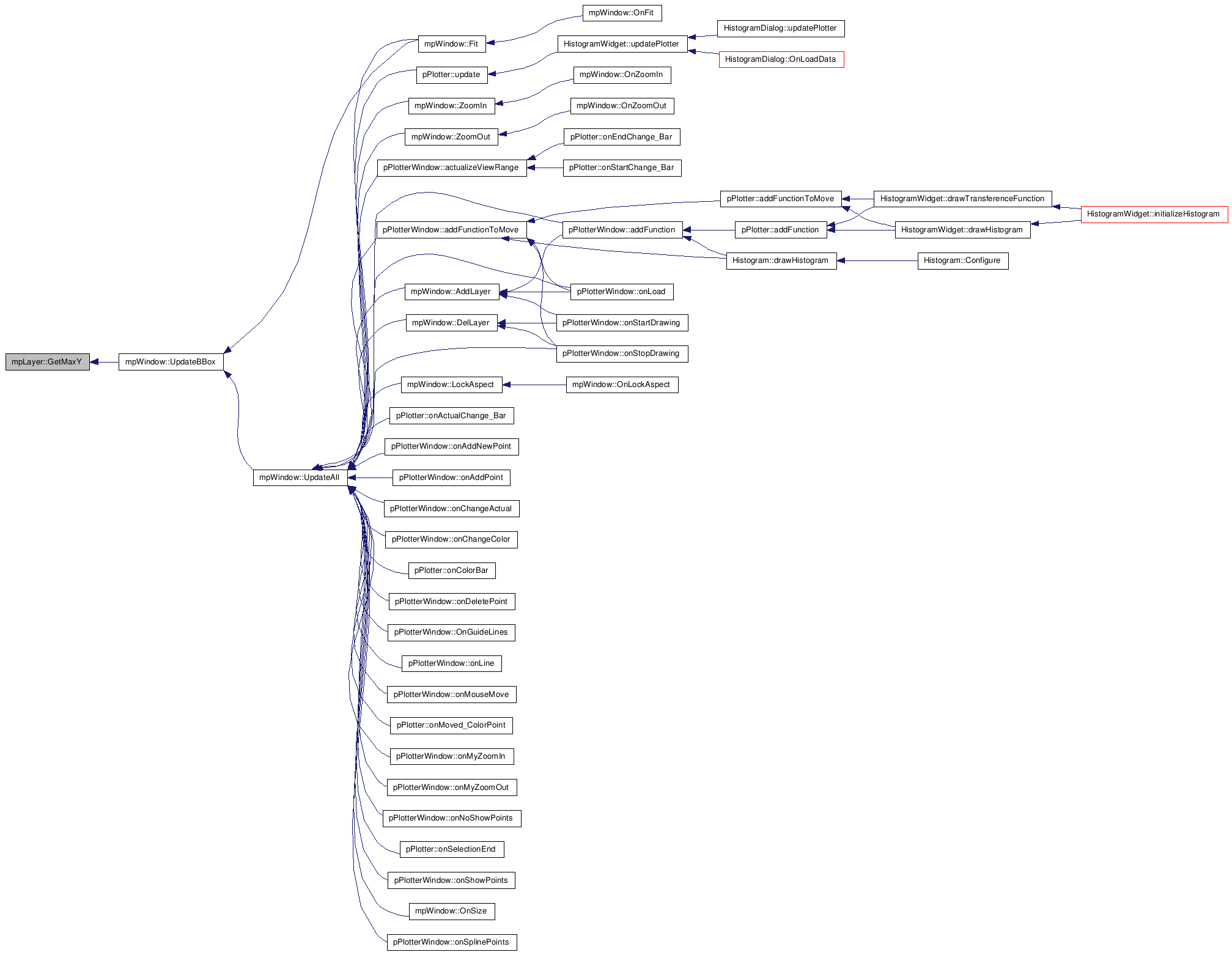
| wxString mpLayer::GetName | ( | ) | const [inline, inherited] |
| const wxFont& mpLayer::GetFont | ( | ) | const [inline, inherited] |
Get font set for this layer.
Definition at line 175 of file mathplot.h.
00175 { return m_font; }
| const wxPen& mpLayer::GetPen | ( | ) | const [inline, inherited] |
Get pen set for this layer.
Definition at line 180 of file mathplot.h.
00180 { return m_pen; }
| void mpLayer::SetName | ( | wxString | name | ) | [inline, inherited] |
Set layer name
| name | Name, will be copied to internal class member |
Definition at line 185 of file mathplot.h.
Referenced by mpFXY::mpFXY(), mpFY::mpFY(), mpScaleX::mpScaleX(), and mpScaleY::mpScaleY().
00185 { m_name = name; }
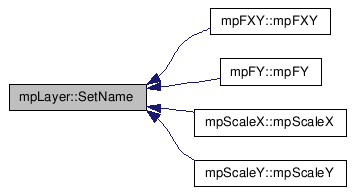
| void mpLayer::SetFont | ( | wxFont & | font | ) | [inline, inherited] |
Set layer font
| font | Font, will be copied to internal class member |
Definition at line 190 of file mathplot.h.
Referenced by mpScaleX::mpScaleX(), and mpScaleY::mpScaleY().
00190 { m_font = font; }

| void mpLayer::SetPen | ( | wxPen & | pen | ) | [inline, inherited] |
Set layer pen
| pen | Pen, will be copied to internal class member |
Definition at line 195 of file mathplot.h.
Referenced by HistogramWidget::drawHistogram(), Histogram::drawHistogram(), HistogramWidget::drawTransferenceFunction(), mpScaleX::mpScaleX(), mpScaleY::mpScaleY(), pPlotterWindow::onChangeColor(), pPlotterWindow::onLoad(), and pPlotterWindow::onStartDrawing().
00195 { m_pen = pen; }

| int mpLayer::GetYTranslated | ( | double | sizey, | |
| double | y | |||
| ) | [inline, inherited] |
Get the translation of the Y coordinate acoording to the new orientation of the axis du to the problem identified in MACOS with the funtion 'SetAxisOrientation'
Definition at line 201 of file mathplot.h.
Referenced by pPlotterLayer::draw(), pPlotterLayer::drawFunction(), pPlotterLayer::drawPoints(), pPlotterLayer::drawSplineCurve(), pPlotterScaleY::Plot(), pPlotterScaleX::Plot(), pPlotterLayer::Plot(), and mpScaleY::Plot().
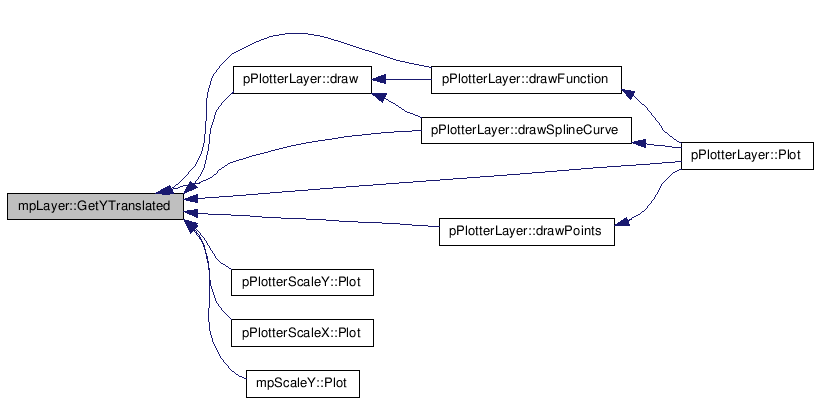
Represents the logical function asociated to this graphical function.
Definition at line 826 of file pGraphicalFunction.h.
Referenced by AddNewPoint(), AddPoint(), addSplinesPoints(), changePoint(), DeletePoint(), deletePointAt(), getBefore(), getDirection(), getEndX(), getEndY(), getIndexOf(), getMaxX(), getMaxY(), getMinX(), getMinY(), GetPointAt(), GetPoints(), getSizePoints(), GetSplinePoint(), getStartX(), getStartY(), getX_RealValues(), getY_RealValues(), initializeSplineVectors(), load(), Rewind(), save(), setEndX(), setEndY(), setMaxX(), setMaxY(), setMinShowed(), setMinX(), setMinY(), setOffsetX(), setOffsetY(), setScales(), setScaleX(), setScaleY(), setStartX(), setStartY(), setType(), setUp(), setValidPointRange(), validPointOnFunction(), and zooming().
bool pGraphicalFunction::showPointsF [private] |
If the function has to showpoints
Definition at line 830 of file pGraphicalFunction.h.
Referenced by getShowPoints(), ifShowPoints(), and SetShowPoints().
double pGraphicalFunction::_startX [private] |
Is the initial discrete point on x axis of the drawed function.
Definition at line 835 of file pGraphicalFunction.h.
Referenced by setStartX().
double pGraphicalFunction::_startY [private] |
Is the initial discrete point on y axis of the drawed function.
Definition at line 839 of file pGraphicalFunction.h.
Referenced by setStartY().
double pGraphicalFunction::_endX [private] |
Is the last discrete point on x axis of the drawed function.
Definition at line 843 of file pGraphicalFunction.h.
Referenced by setEndX().
double pGraphicalFunction::_endY [private] |
Is the last discrete point on y axis of the drawed function.
Definition at line 847 of file pGraphicalFunction.h.
Referenced by setEndY().
double pGraphicalFunction::_scaleX [private] |
Is the x-scale percentage according to the context device.
Definition at line 851 of file pGraphicalFunction.h.
Referenced by getScales(), getScaleX(), setOffsets(), setScaleX(), and zooming().
double pGraphicalFunction::_scaleY [private] |
Is the y-scale percentage according to the context device.
Definition at line 855 of file pGraphicalFunction.h.
Referenced by getScales(), getScaleY(), setOffsets(), setScaleY(), and zooming().
double pGraphicalFunction::_minX [private] |
Is the minimun x-real value reacheable by the function.
Definition at line 859 of file pGraphicalFunction.h.
Referenced by setMinX().
double pGraphicalFunction::_minY [private] |
Is the minimun y-real value reacheable by the function.
Definition at line 863 of file pGraphicalFunction.h.
Referenced by setMinY().
double pGraphicalFunction::_maxX [private] |
Is the maximun x-real value reacheable by the function.
Definition at line 867 of file pGraphicalFunction.h.
Referenced by setMaxX().
double pGraphicalFunction::_maxY [private] |
Is the maximun y-real value reacheable by the function.
Definition at line 871 of file pGraphicalFunction.h.
Referenced by setMaxY().
double pGraphicalFunction::_offsetX [private] |
Is the logical x-offset of the drawed function.
Definition at line 875 of file pGraphicalFunction.h.
Referenced by getOffsets(), getOffsetX(), setMinShowed(), setOffsets(), setOffsetX(), and zooming().
double pGraphicalFunction::_offsetY [private] |
Is the logical y-offset of the drawed function.
Definition at line 879 of file pGraphicalFunction.h.
Referenced by getOffsets(), getOffsetY(), setMinShowed(), setOffsets(), setOffsetY(), and zooming().
int pGraphicalFunction::_type [private] |
Is the way of how points are going to be connected. It could be smooth, line.
Definition at line 883 of file pGraphicalFunction.h.
Referenced by getType(), setType(), and vGetType().
wxList pGraphicalFunction::realPoints [private] |
The list of the function points
Definition at line 887 of file pGraphicalFunction.h.
std::vector<pColorPoint *> pGraphicalFunction::f_colorPoints [private] |
Definition at line 891 of file pGraphicalFunction.h.
Referenced by getColorPoints(), and setColorPoints().
wxNode* pGraphicalFunction::node [private] |
node of the realPoints where are we
Definition at line 896 of file pGraphicalFunction.h.
Referenced by addSplinesPoints(), getBefore(), GetNextXY(), Rewind(), and setMinShowed().
int pGraphicalFunction::validPointRange [private] |
Number that determines the radius range for the valid area the point (sensible radius). Default value 5.
Definition at line 900 of file pGraphicalFunction.h.
Referenced by getValidPointRange(), and setValidPointRange().
bool pGraphicalFunction::drawing [private] |
Indicates if the user is drawing the function
Definition at line 905 of file pGraphicalFunction.h.
Referenced by GetDrawing(), getDrawing(), and SetDrawing().
wxPoint pGraphicalFunction::mousePoint [private] |
this is for the graphical function Mouse Point
Definition at line 911 of file pGraphicalFunction.h.
Referenced by getMousePoint(), and SetMousePoint().
int pGraphicalFunction::screenX [private] |
The size of the screen in X
Definition at line 916 of file pGraphicalFunction.h.
Referenced by getScreens(), getScreenX(), setScales(), setScreens(), and setScreenX().
int pGraphicalFunction::screenY [private] |
The size of the screen in Y
Definition at line 921 of file pGraphicalFunction.h.
Referenced by getScreens(), getScreenY(), setScales(), setScreens(), and setScreenY().
bool pGraphicalFunction::ifActual [private] |
if is the actual
Definition at line 925 of file pGraphicalFunction.h.
Referenced by getActual(), getIfActual(), and setActual().
int pGraphicalFunction::scaleWay [private] |
the way we scale DEFECT_SCALE 1 MAX_SCALE 2 USER_SCALE 3
Definition at line 934 of file pGraphicalFunction.h.
Referenced by getScaleWay(), and setScaleWay().
bool pGraphicalFunction::fromWindow [private] |
if the function comes from window
Definition at line 939 of file pGraphicalFunction.h.
Referenced by AddNewPoint(), AddPoint(), changePoint(), DeletePoint(), deletePointAt(), getFromWindow(), getFromWindowV(), and setFromWindow().
float pGraphicalFunction::factorZoom [private] |
factorZoom
Definition at line 943 of file pGraphicalFunction.h.
Referenced by getFactorZoom(), setFactorZoom(), and setScales().
bool pGraphicalFunction::editable [private] |
The function is editable
Definition at line 947 of file pGraphicalFunction.h.
Referenced by getEditable(), and setEditable().
bool pGraphicalFunction::zoomIn [private] |
if the user did a zoom in/out
Definition at line 951 of file pGraphicalFunction.h.
Referenced by getZoomB(), setZoomIn(), and zooming().
initial drawing point
Definition at line 955 of file pGraphicalFunction.h.
Referenced by getInitialDrawPoint(), setInitialDrawPoint(), and zooming().
final drawing point
Definition at line 959 of file pGraphicalFunction.h.
Referenced by getFinallDrawPoint(), setFinalDrawPoint(), and zooming().
int pGraphicalFunction::minShowedX [private] |
Minimum point showed to the user (zoom)X
Definition at line 964 of file pGraphicalFunction.h.
Referenced by getMinXShowed(), setMinShowedX(), setOffsets(), and setScales().
int pGraphicalFunction::maxShowedX [private] |
Maximum point showed to the user (zoom)X
Definition at line 969 of file pGraphicalFunction.h.
Referenced by getMaxXShowed(), setMaxShowedX(), and setScales().
int pGraphicalFunction::minShowedY [private] |
Minimum point showed to the user (zoom)Y
Definition at line 974 of file pGraphicalFunction.h.
Referenced by getMinYShowed(), setMinShowedY(), setOffsets(), and setScales().
int pGraphicalFunction::maxShowedY [private] |
Maximum point showed to the user (zoom)X
Definition at line 979 of file pGraphicalFunction.h.
Referenced by getMaxYShowed(), setMaxShowedY(), and setScales().
std::vector<double> pGraphicalFunction::xSpline [private] |
Definition at line 985 of file pGraphicalFunction.h.
Referenced by clearSplineVectors(), getXSpline(), and initializeSplineVectors().
std::vector<double> pGraphicalFunction::ySpline [private] |
Definition at line 987 of file pGraphicalFunction.h.
Referenced by clearSplineVectors(), getYSpline(), and initializeSplineVectors().
vtkKochanekSpline* pGraphicalFunction::xKSpline [private] |
Definition at line 992 of file pGraphicalFunction.h.
Referenced by addSplinesPoints(), GetSplinePoint(), and initializeSplines().
vtkKochanekSpline* pGraphicalFunction::yKSpline [private] |
Definition at line 994 of file pGraphicalFunction.h.
Referenced by addSplinesPoints(), GetSplinePoint(), and initializeSplines().
int pGraphicalFunction::offsetPixelX [private] |
offset in pixels where the user has clicked before changing the scale
Definition at line 1001 of file pGraphicalFunction.h.
Referenced by getOffsetPixelsX(), getOffsetPixelsXv(), setOffsetPixelX(), and setOffsets().
int pGraphicalFunction::offsetPixelY [private] |
Definition at line 1002 of file pGraphicalFunction.h.
Referenced by getOffsetPixelsY(), getOffsetPixelsYv(), setOffsetPixelY(), and setOffsets().
int pGraphicalFunction::mType [private] |
int pGraphicalFunction::xTraslation [private] |
Definition at line 1014 of file pGraphicalFunction.h.
Referenced by getXTraslation(), and setXTraslation().
int pPlotterLayer::m_flags [protected, inherited] |
wxList pPlotterLayer::points [protected, inherited] |
Definition at line 231 of file pPlotterLayer.h.
Referenced by pPlotterLayer::drawFunction(), pPlotterLayer::drawLineToMousePoint(), and pPlotterLayer::drawPoints().
double pPlotterLayer::scaleX [protected, inherited] |
Definition at line 235 of file pPlotterLayer.h.
Referenced by pPlotterLayer::drawFunction(), pPlotterLayer::drawLineToMousePoint(), pPlotterLayer::drawPoints(), pPlotterLayer::drawSplineCurve(), pPlotterScaleX::Plot(), pPlotterLayer::Plot(), and setScales().
double pPlotterLayer::scaleY [protected, inherited] |
Definition at line 239 of file pPlotterLayer.h.
Referenced by pPlotterLayer::drawFunction(), pPlotterLayer::drawLineToMousePoint(), pPlotterLayer::drawPoints(), pPlotterLayer::drawSplineCurve(), pPlotterScaleY::Plot(), pPlotterLayer::Plot(), and setScales().
int pPlotterLayer::offsetX [protected, inherited] |
offset X
Definition at line 244 of file pPlotterLayer.h.
Referenced by pPlotterLayer::drawFunction(), pPlotterLayer::drawLineToMousePoint(), pPlotterLayer::drawPoints(), pPlotterLayer::drawSplineCurve(), pPlotterScaleX::Plot(), and pPlotterLayer::Plot().
int pPlotterLayer::offsetY [protected, inherited] |
offset Y
Definition at line 249 of file pPlotterLayer.h.
Referenced by pPlotterLayer::drawFunction(), pPlotterLayer::drawLineToMousePoint(), pPlotterLayer::drawPoints(), pPlotterLayer::drawSplineCurve(), getOffsets(), pPlotterScaleY::Plot(), and pPlotterLayer::Plot().
wxFont mpLayer::m_font [protected, inherited] |
Layer's font.
Definition at line 206 of file mathplot.h.
Referenced by pPlotterScaleY::Plot(), pPlotterScaleX::Plot(), mpScaleY::Plot(), mpScaleX::Plot(), mpFXY::Plot(), mpFY::Plot(), and mpFX::Plot().
wxPen mpLayer::m_pen [protected, inherited] |
Layer's pen.
Definition at line 207 of file mathplot.h.
Referenced by pPlotterScaleY::Plot(), pPlotterScaleX::Plot(), pPlotterLayer::Plot(), mpScaleY::Plot(), mpScaleX::Plot(), mpFXY::Plot(), mpFY::Plot(), and mpFX::Plot().
wxString mpLayer::m_name [protected, inherited] |
Layer's name.
Definition at line 208 of file mathplot.h.
Referenced by mpScaleY::Plot(), mpScaleX::Plot(), mpFXY::Plot(), mpFY::Plot(), and mpFX::Plot().
 1.5.3
1.5.3